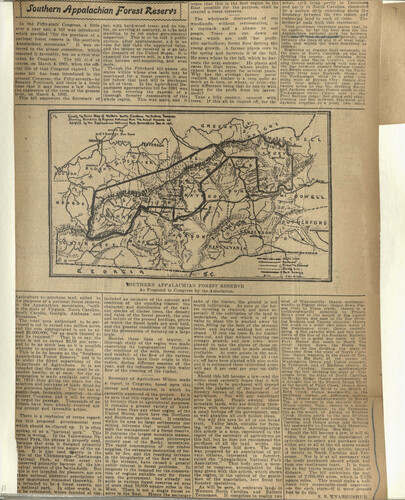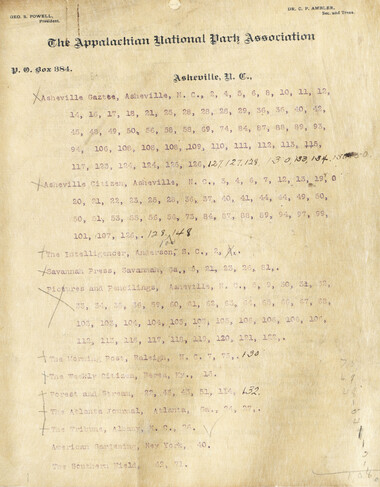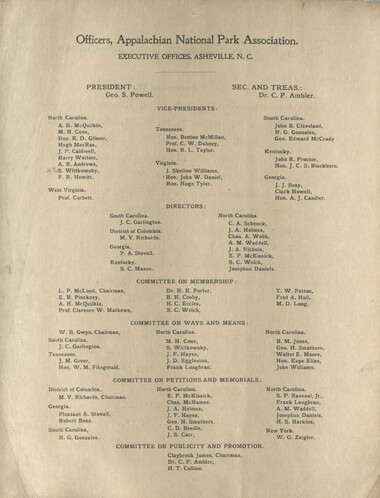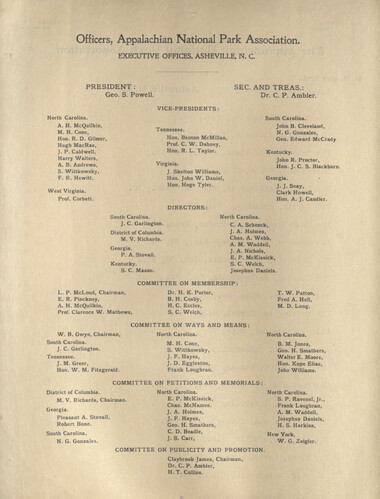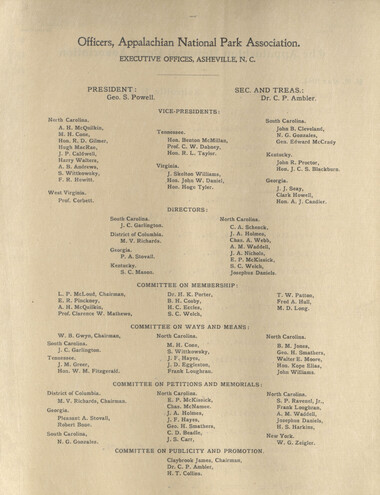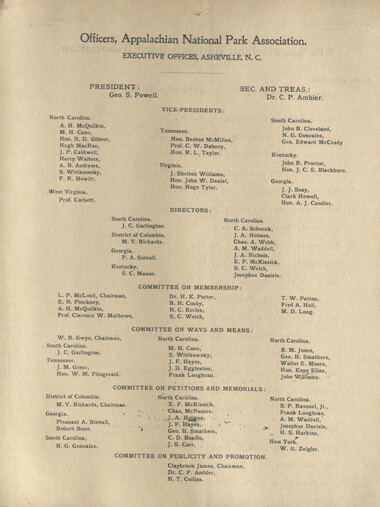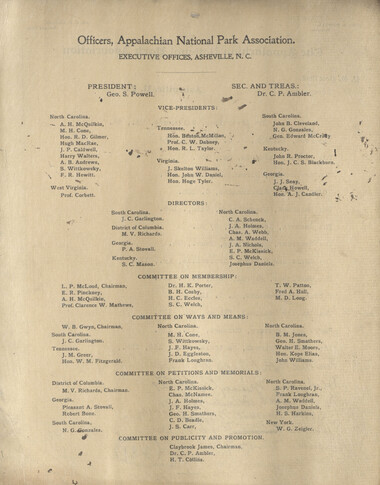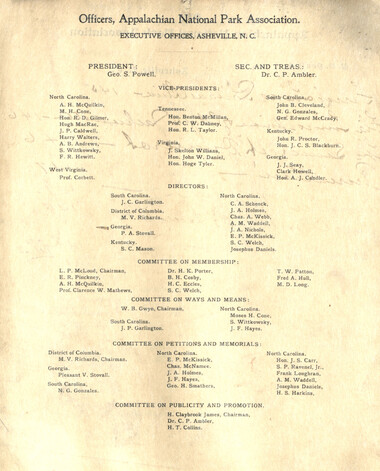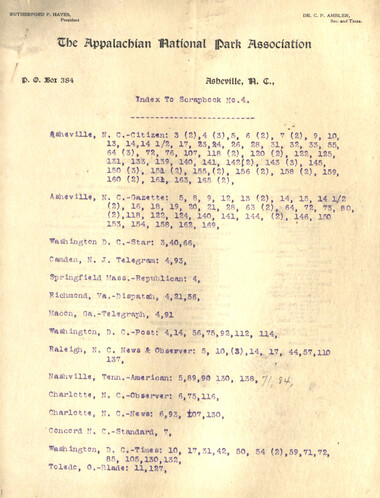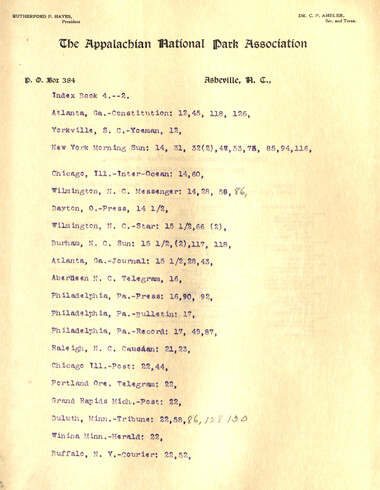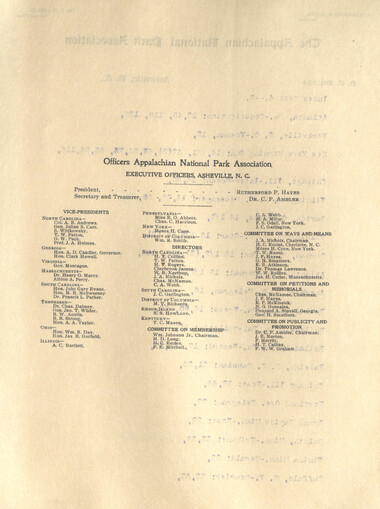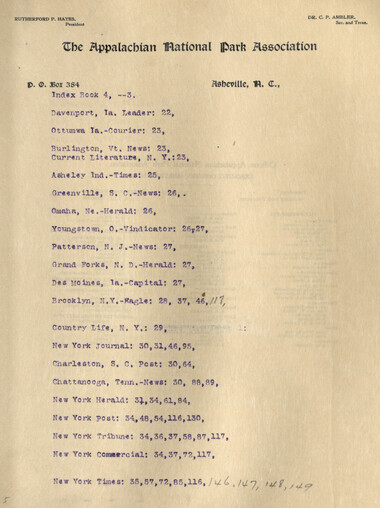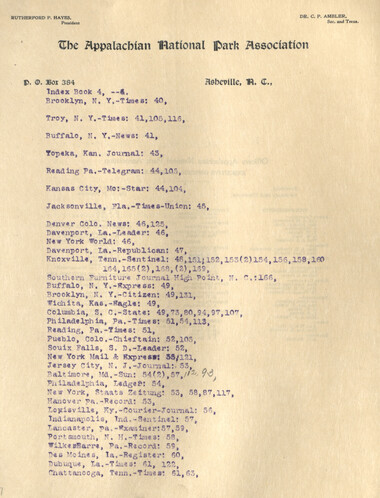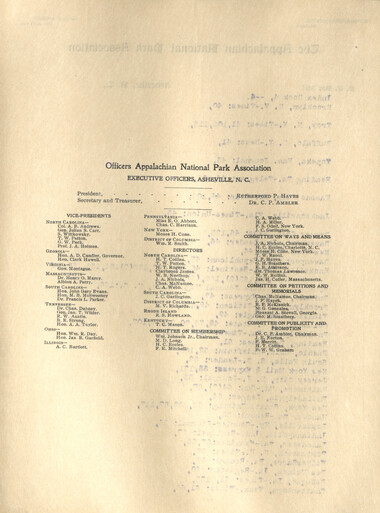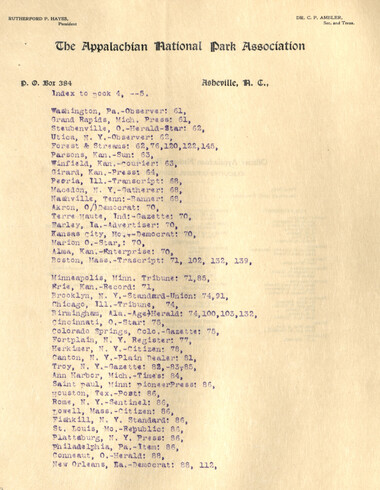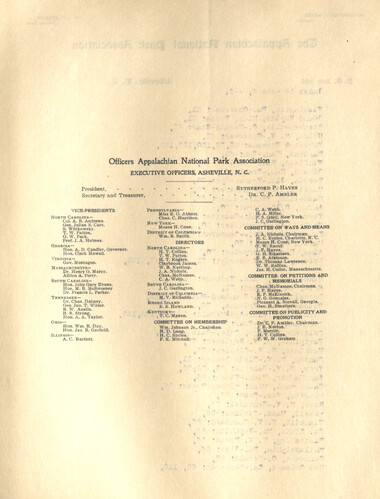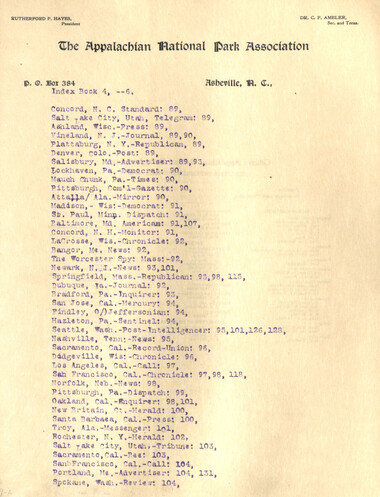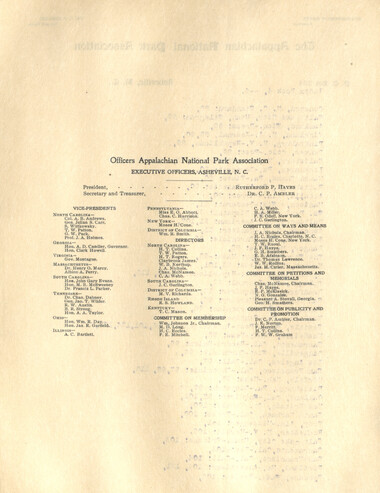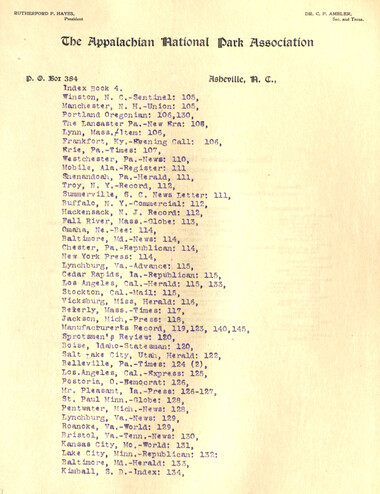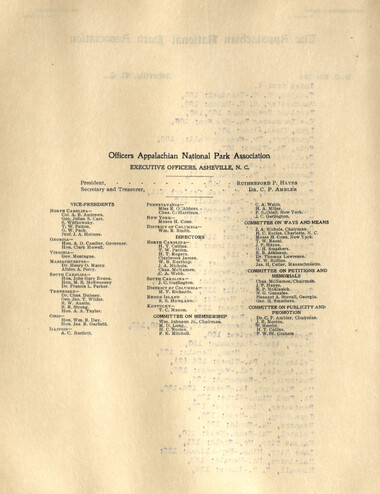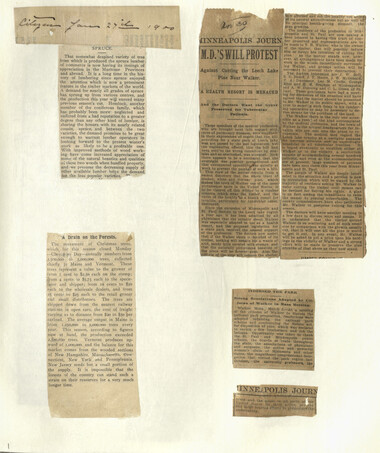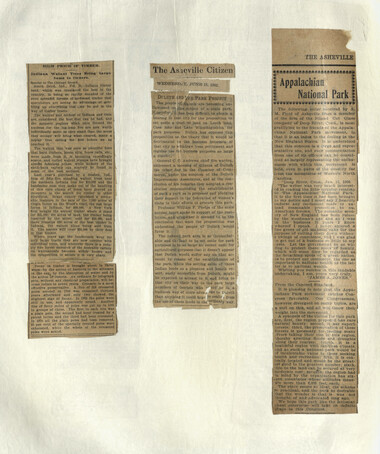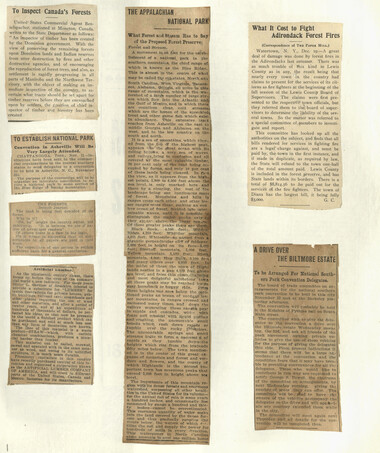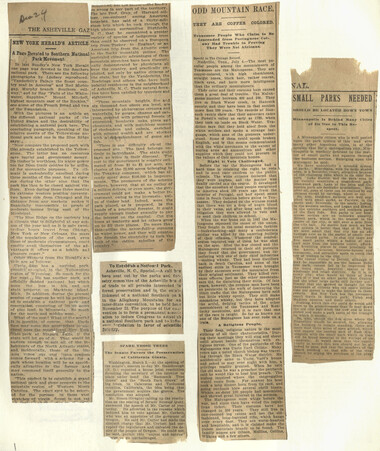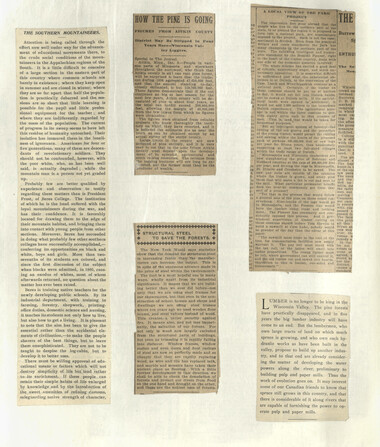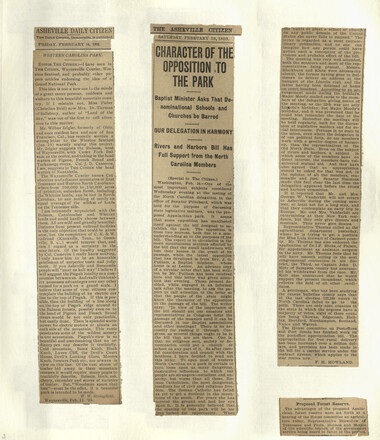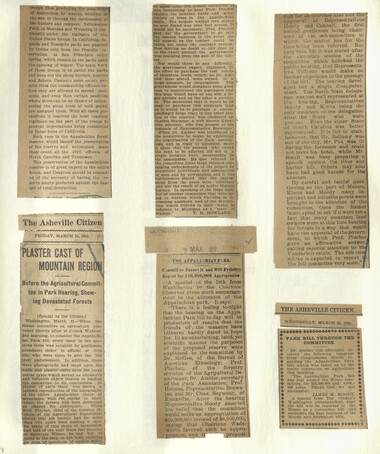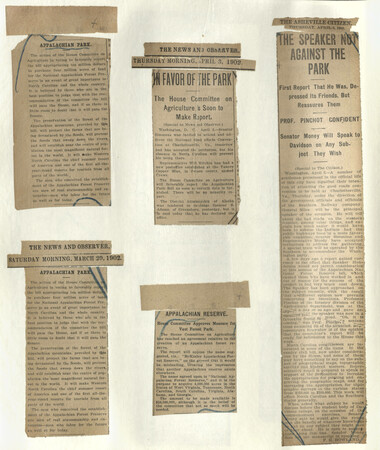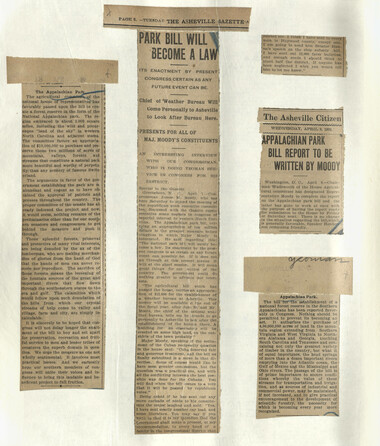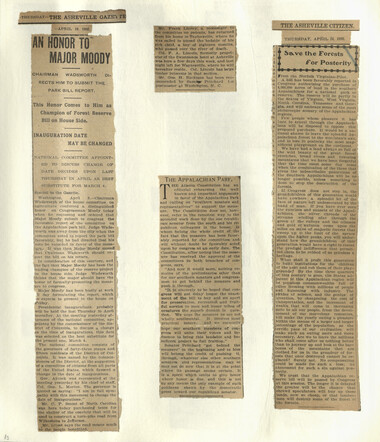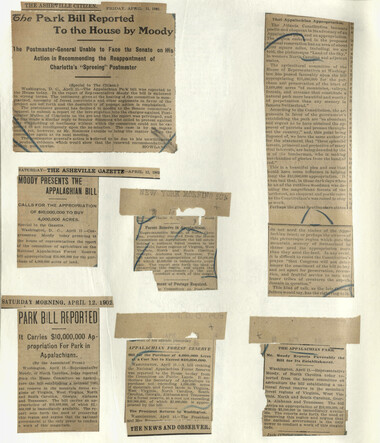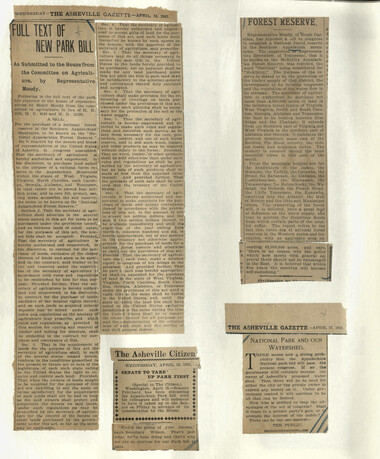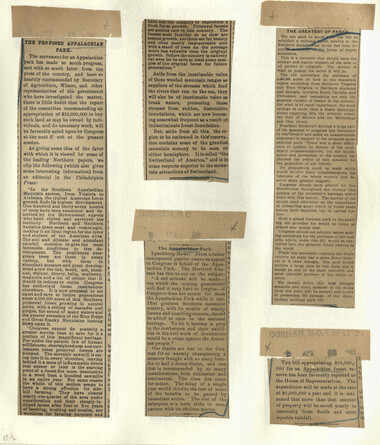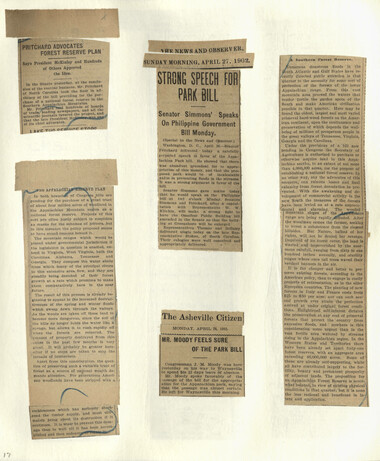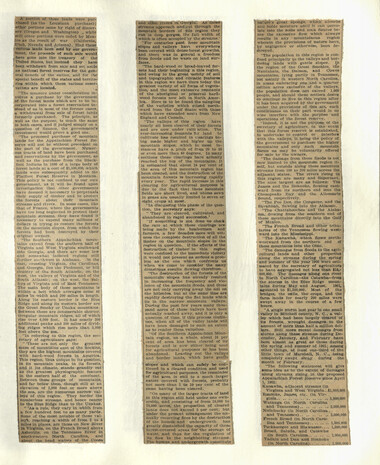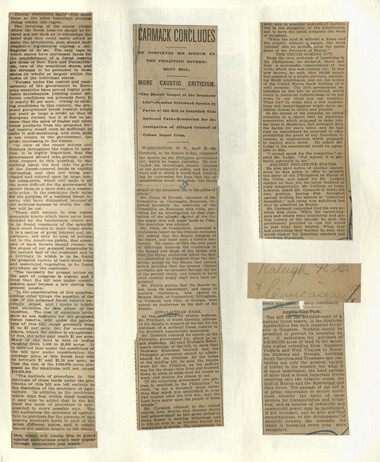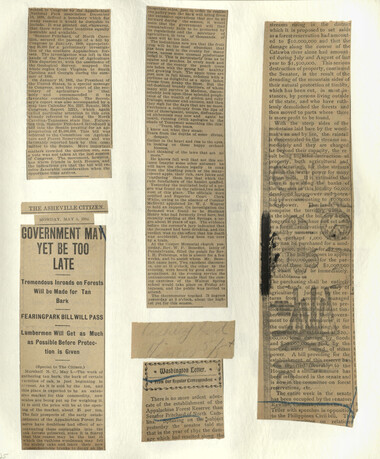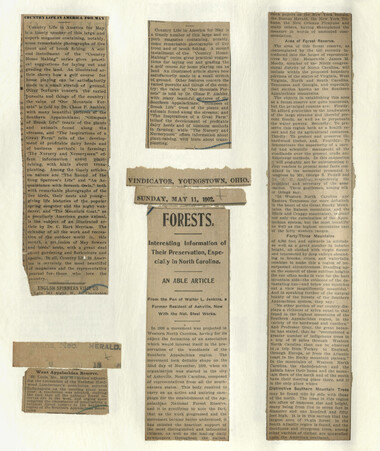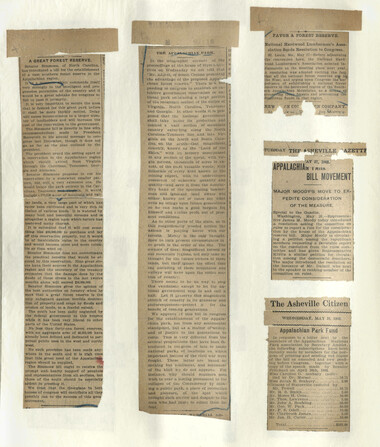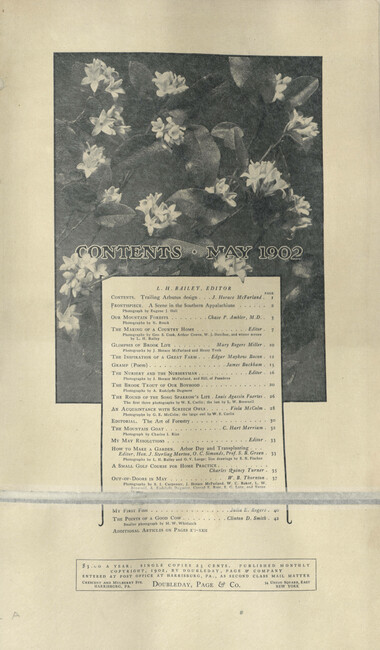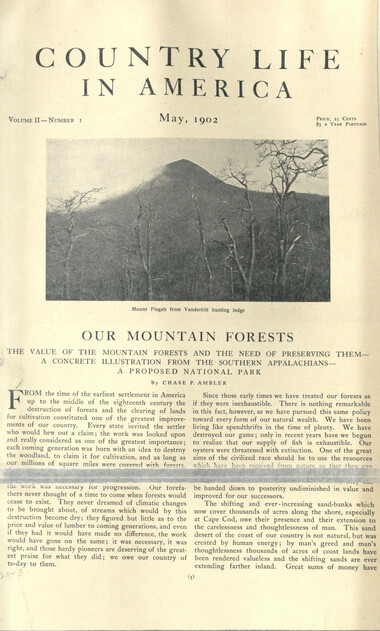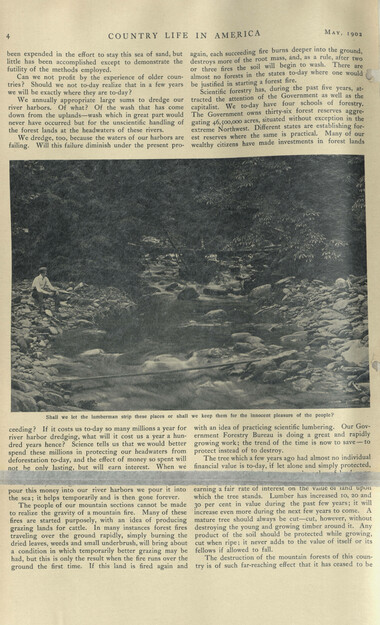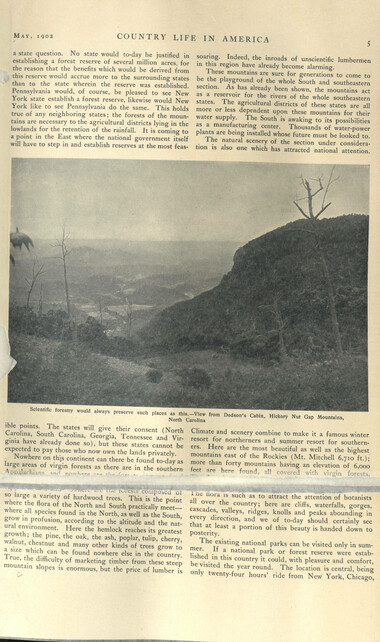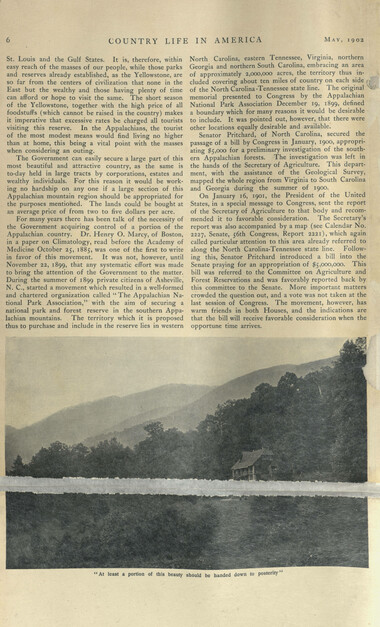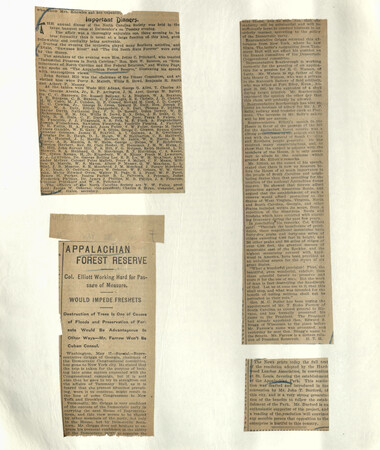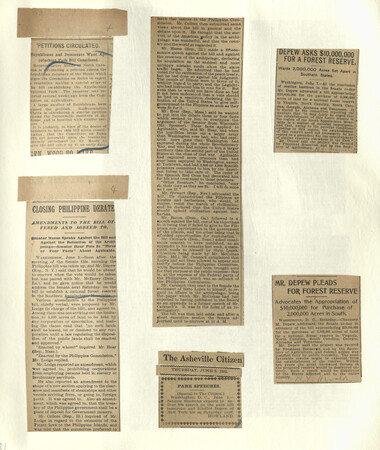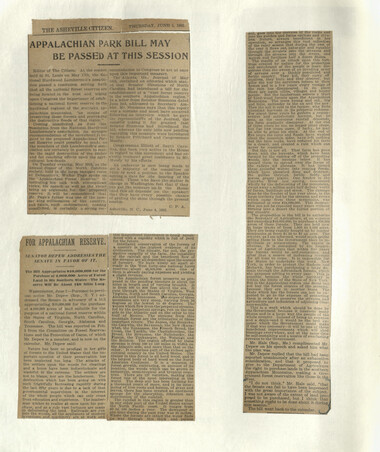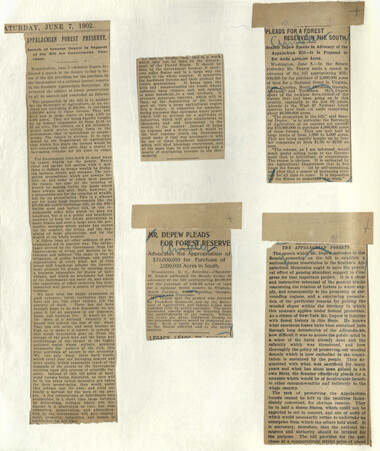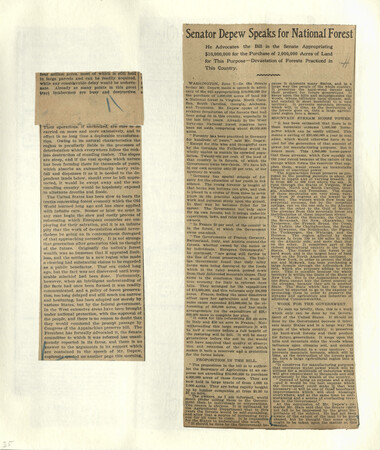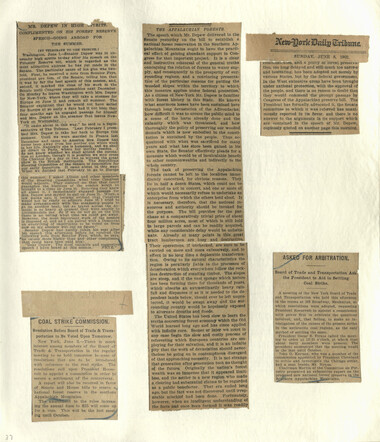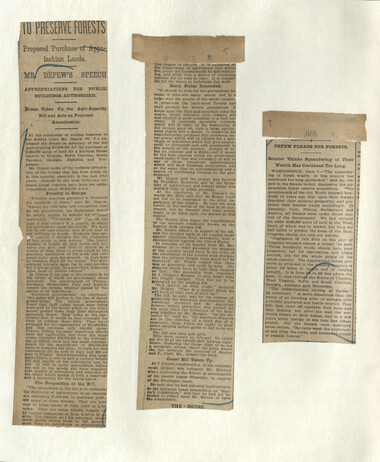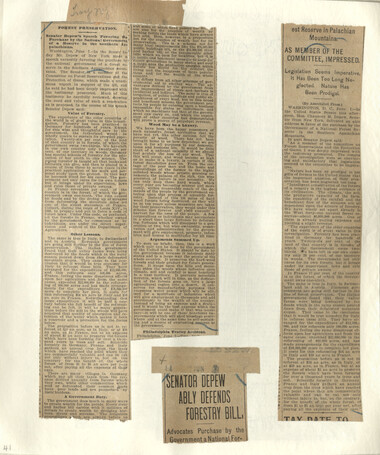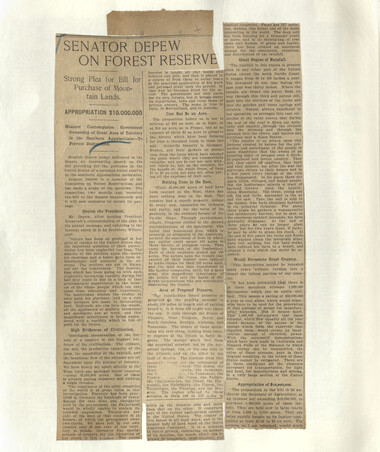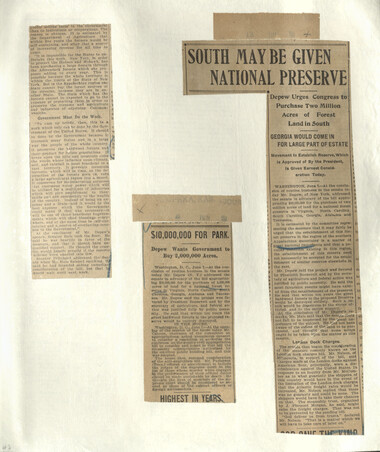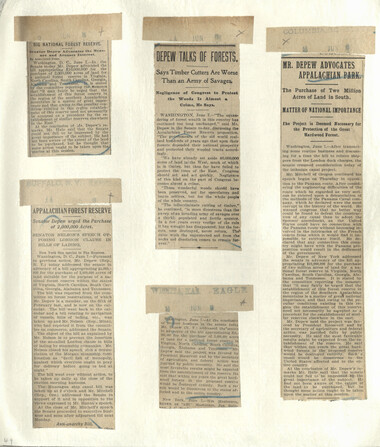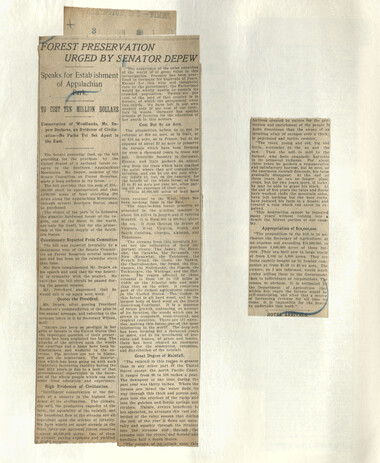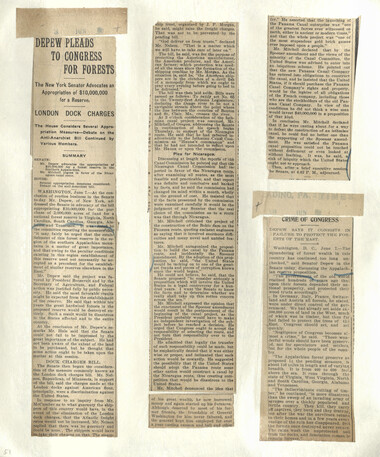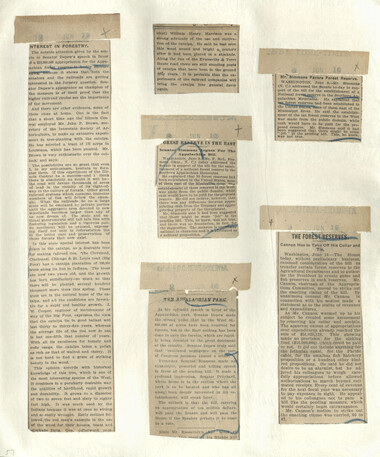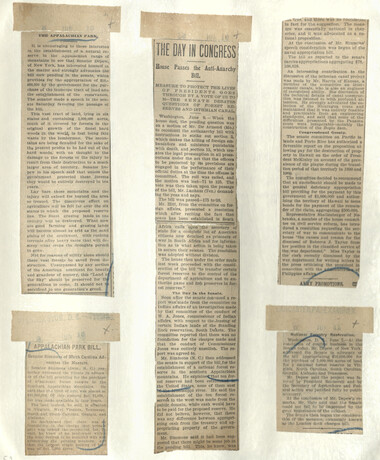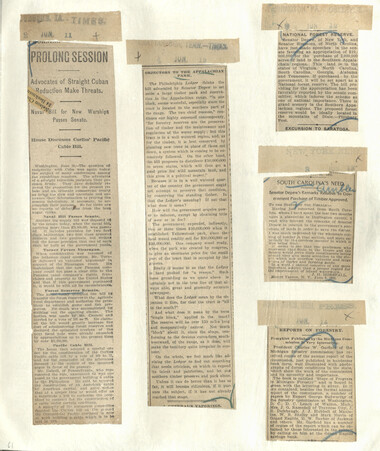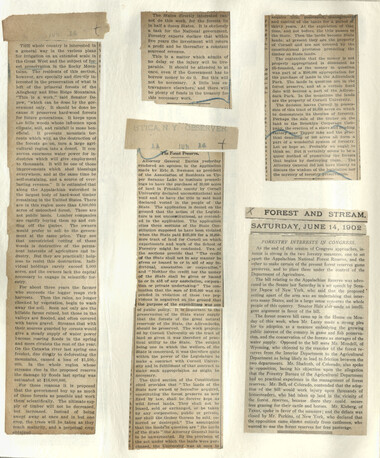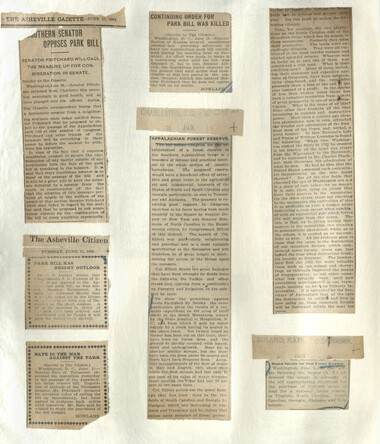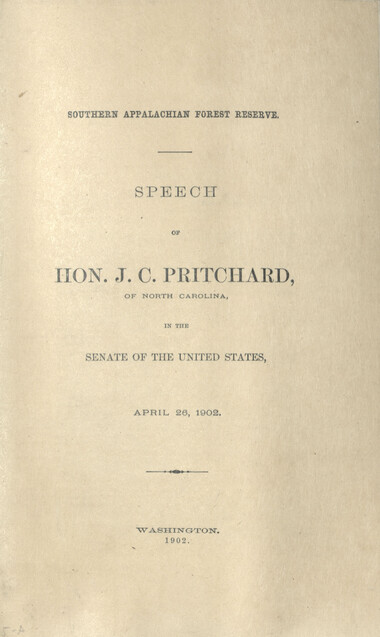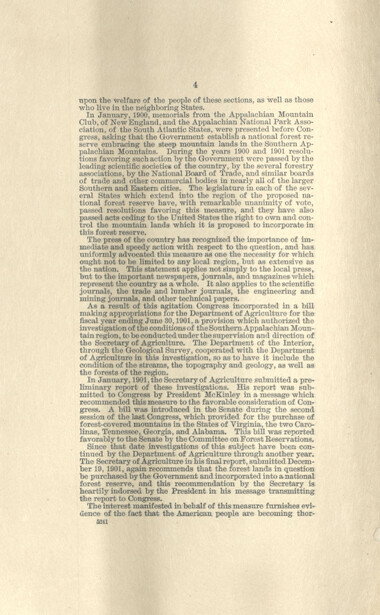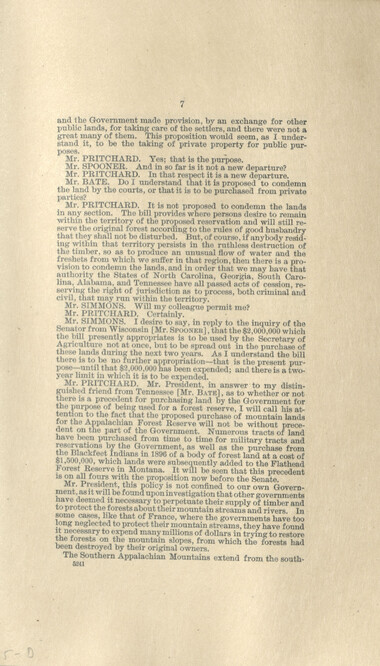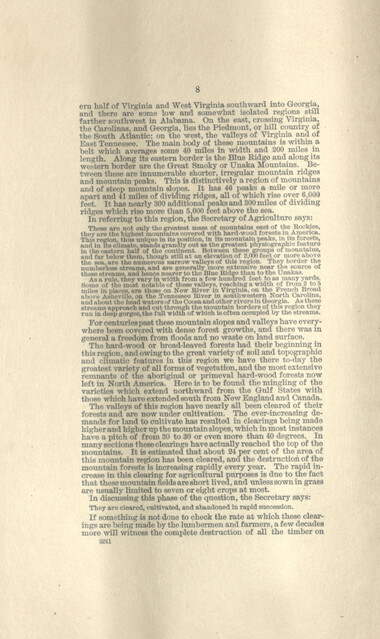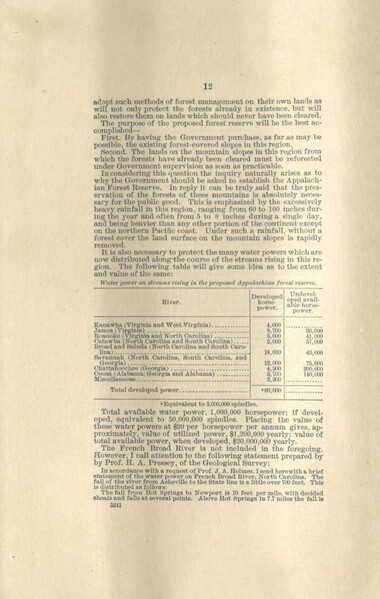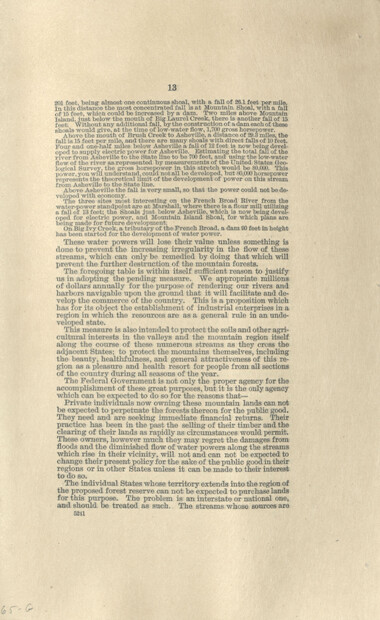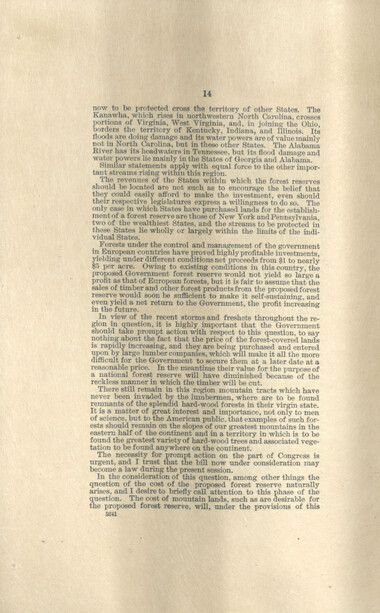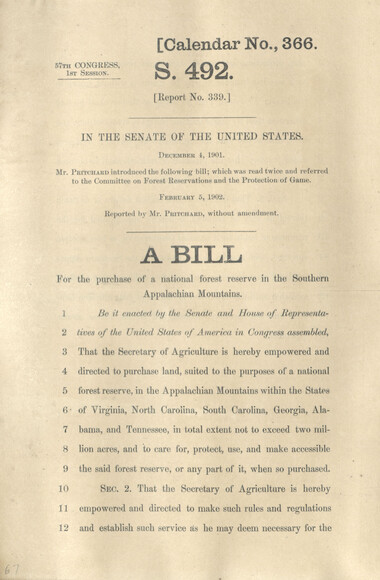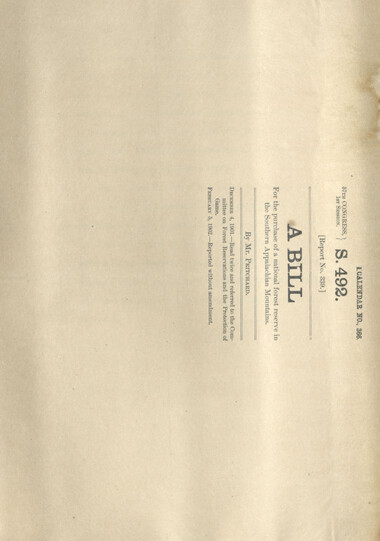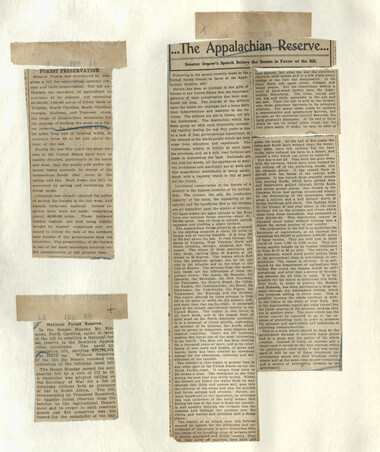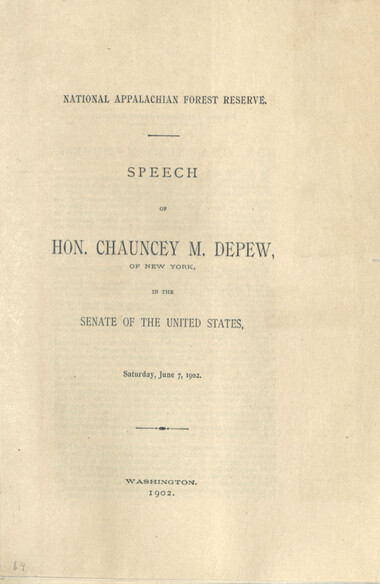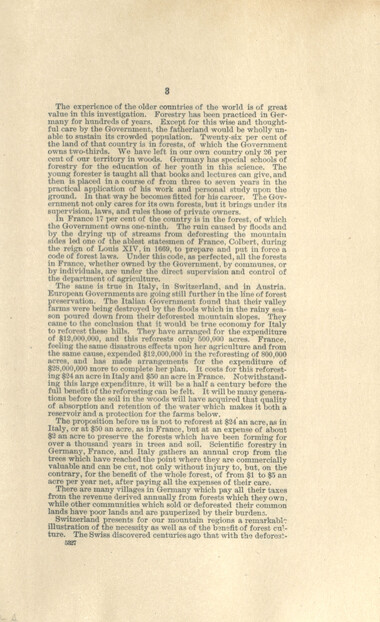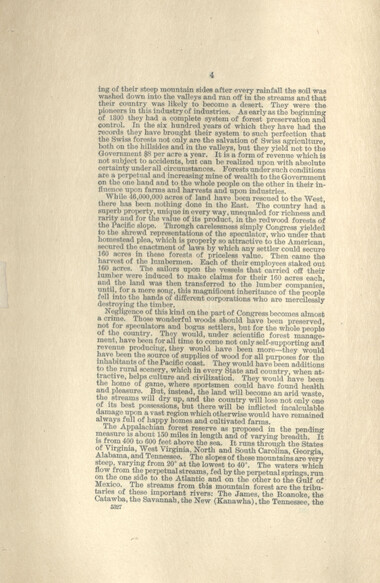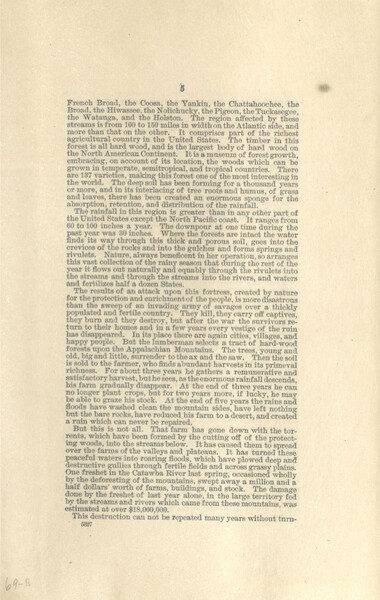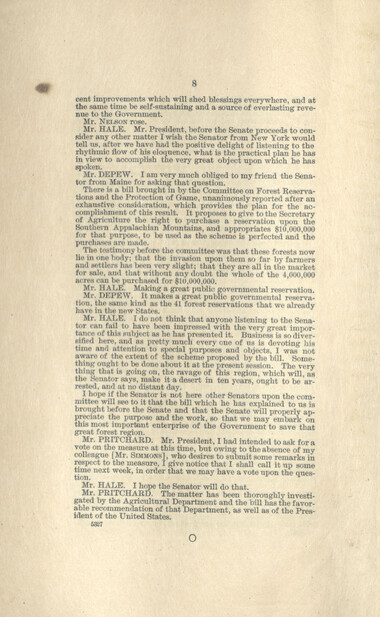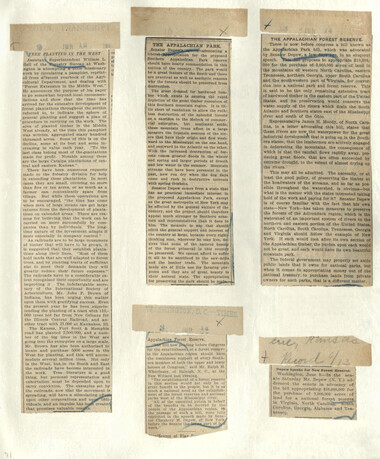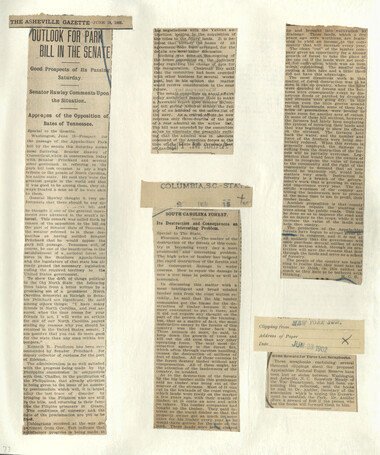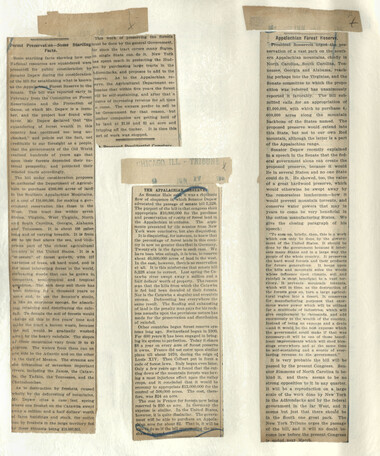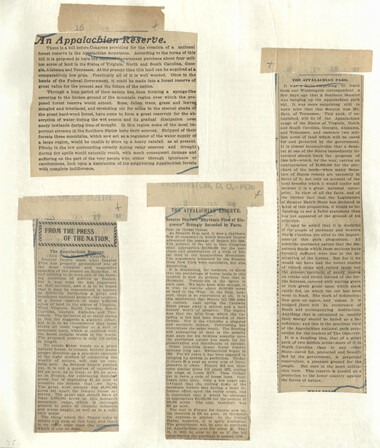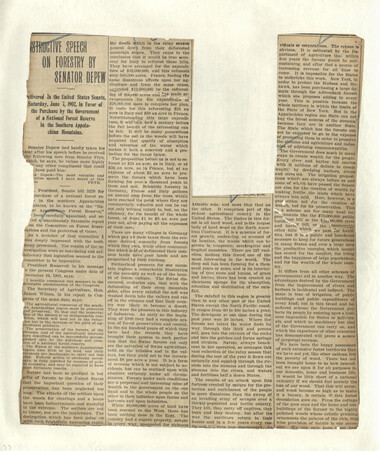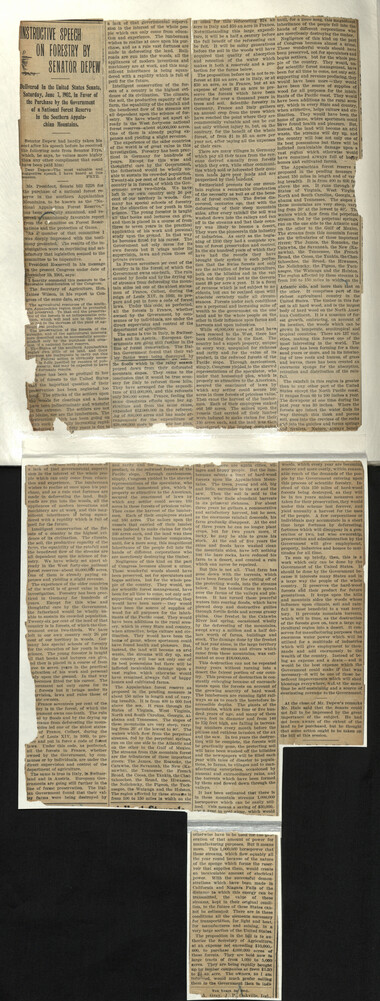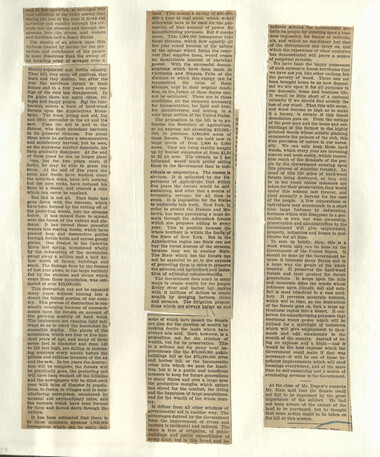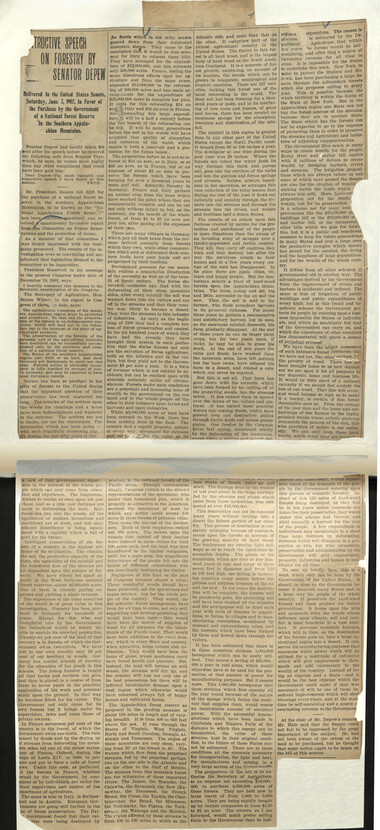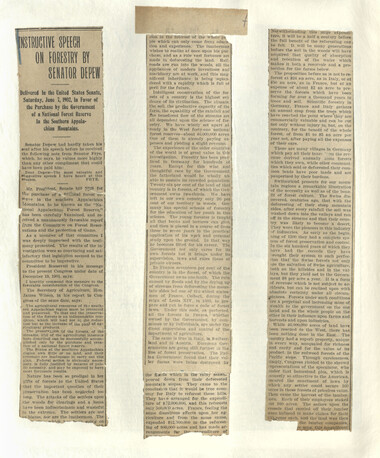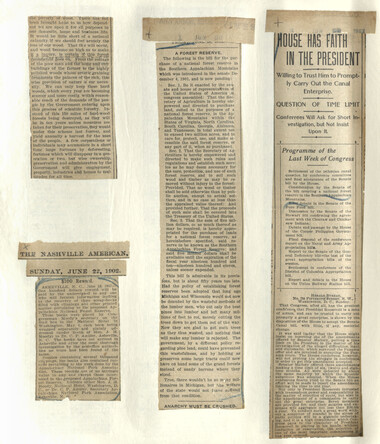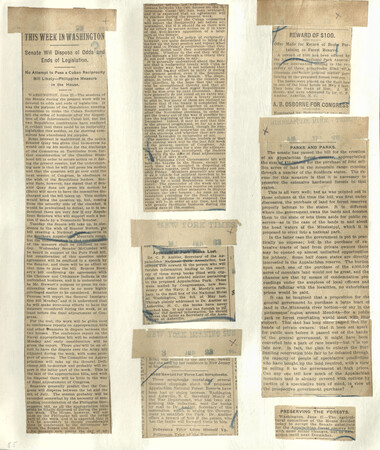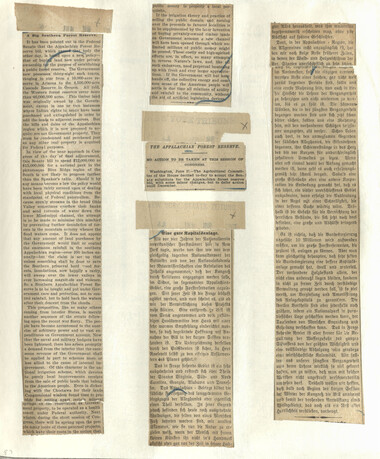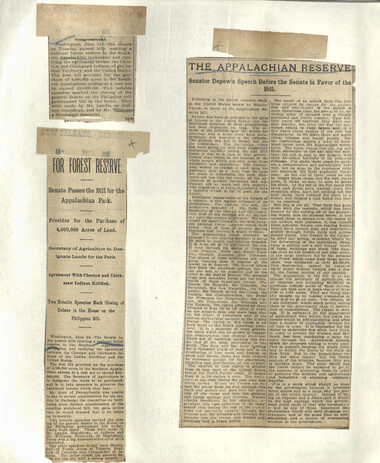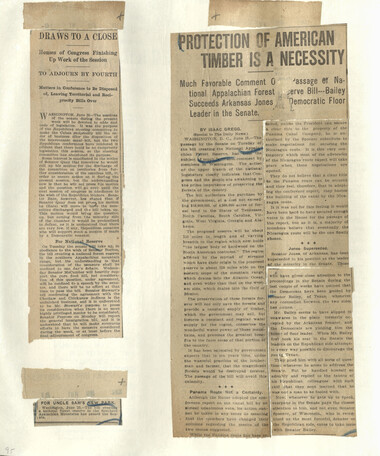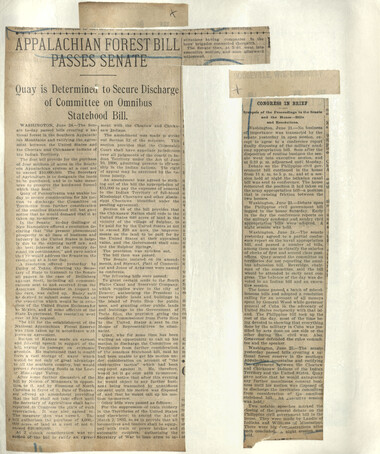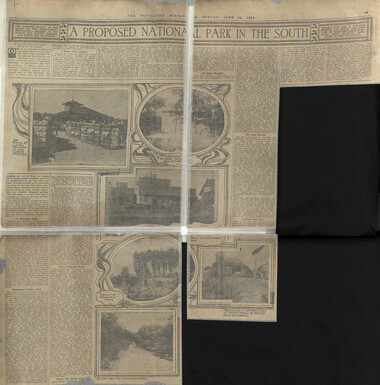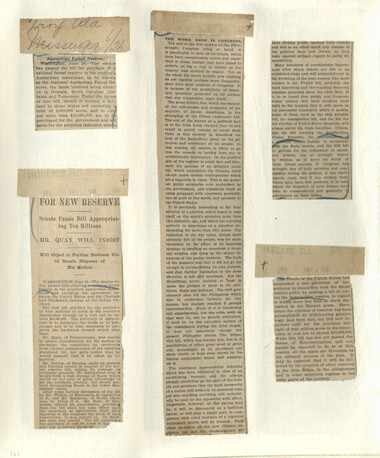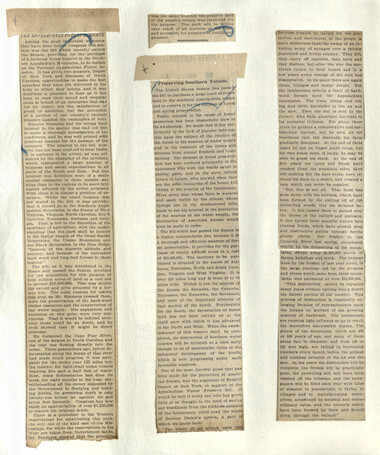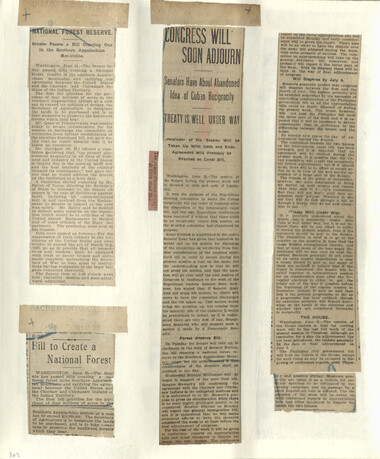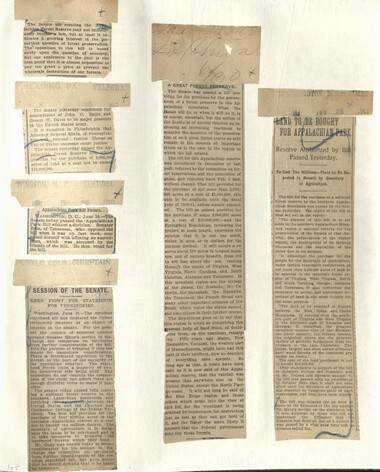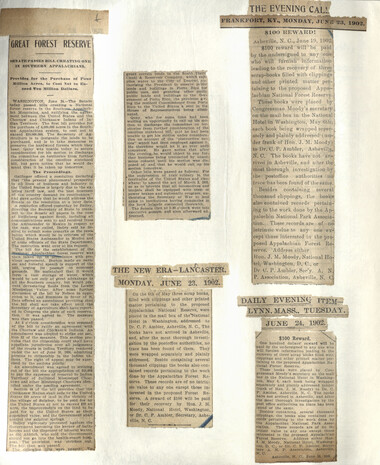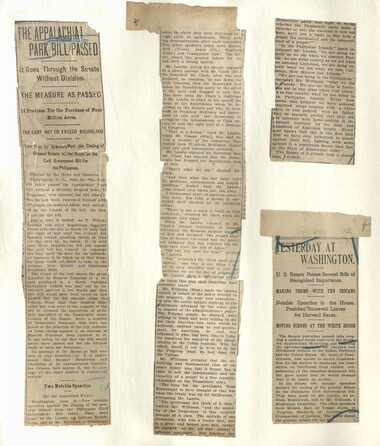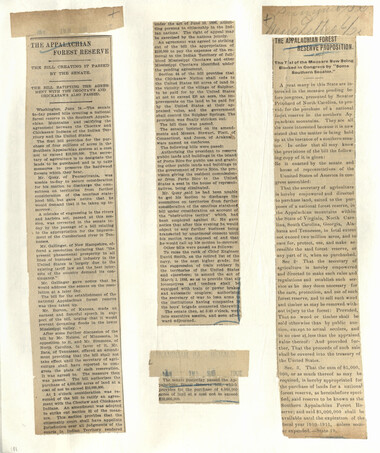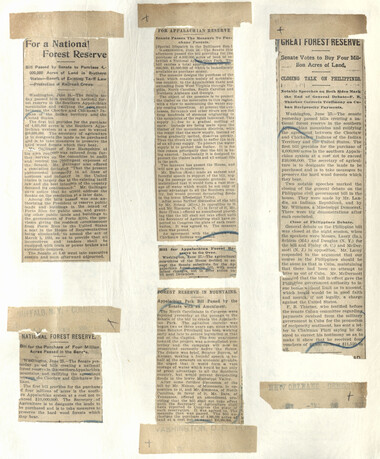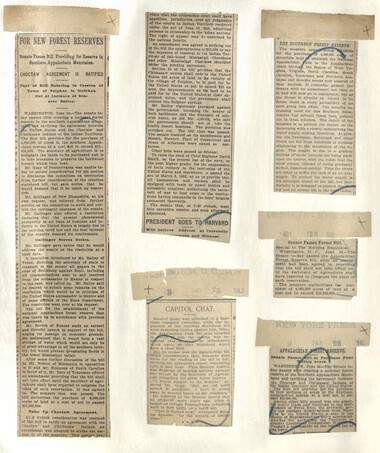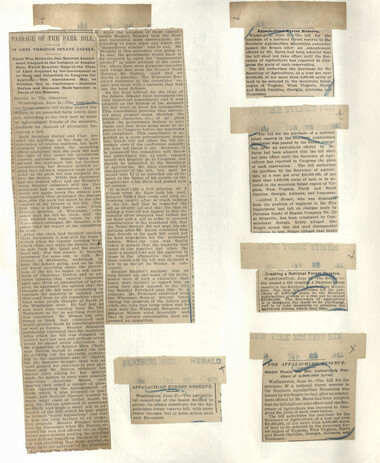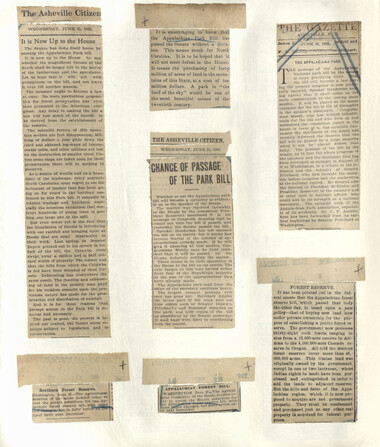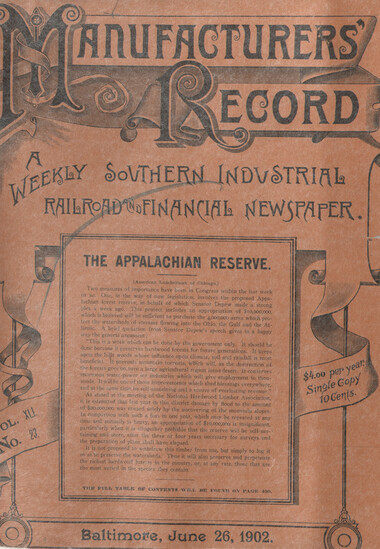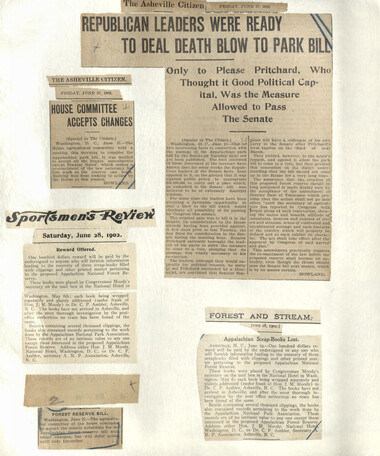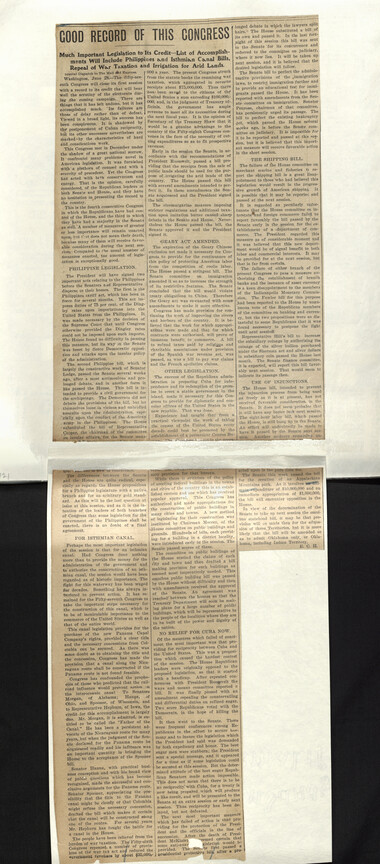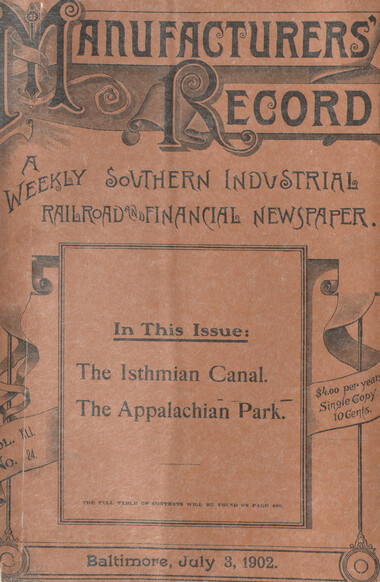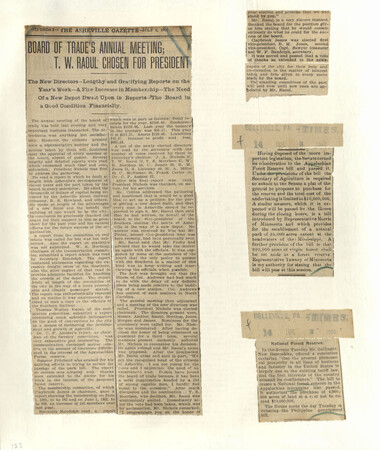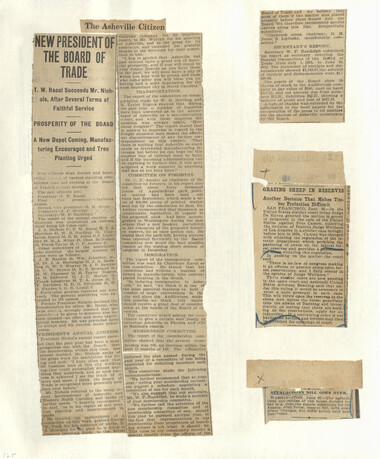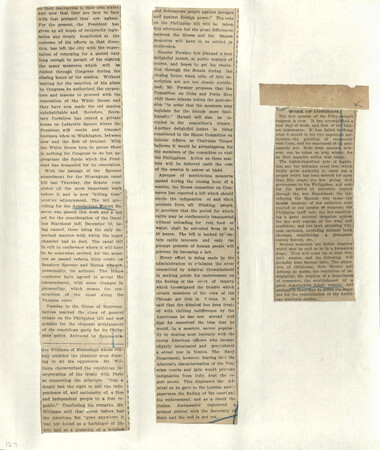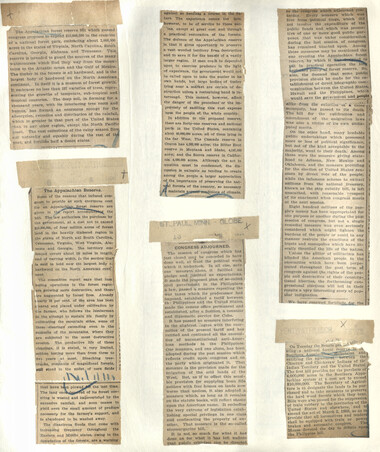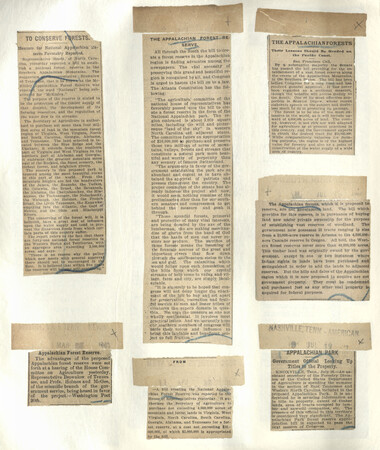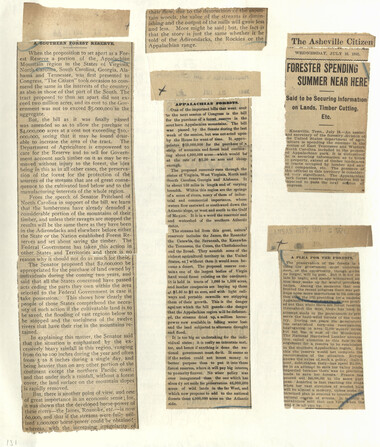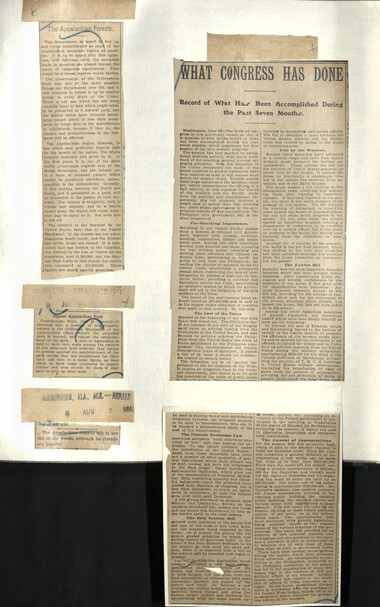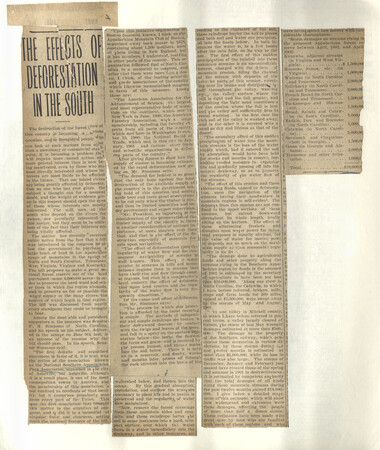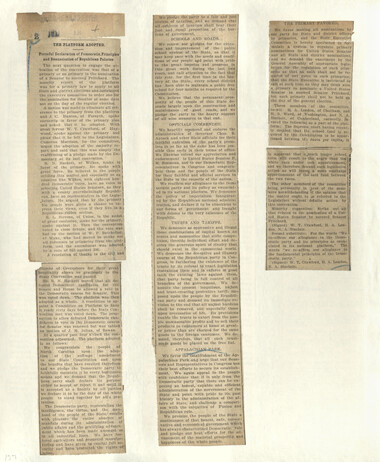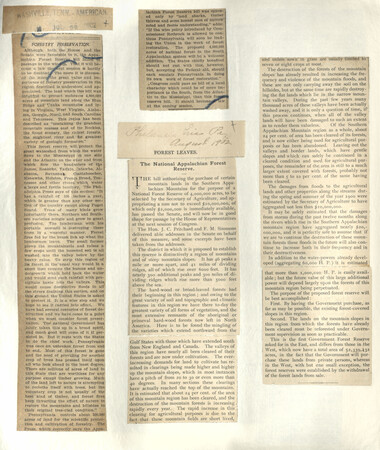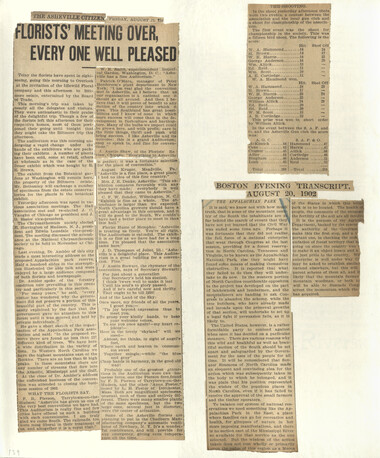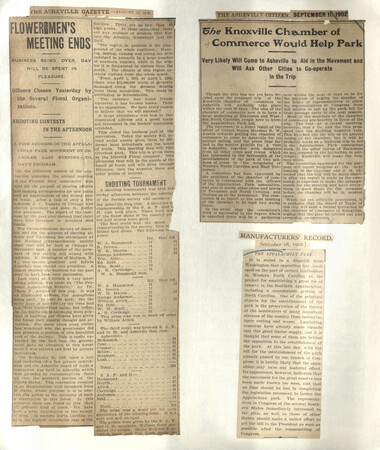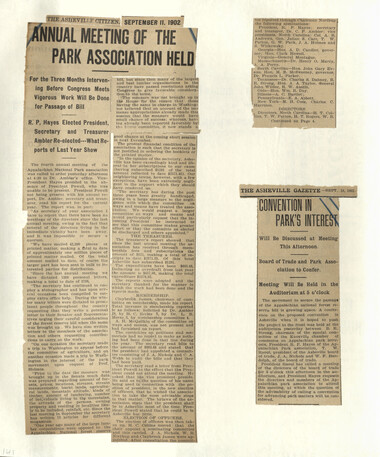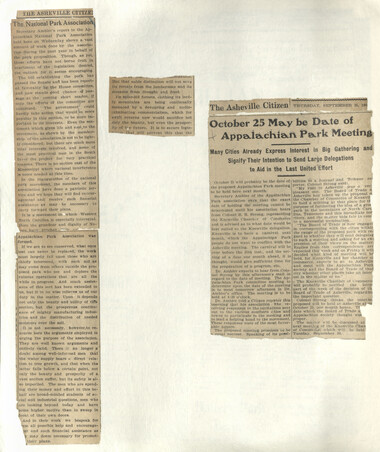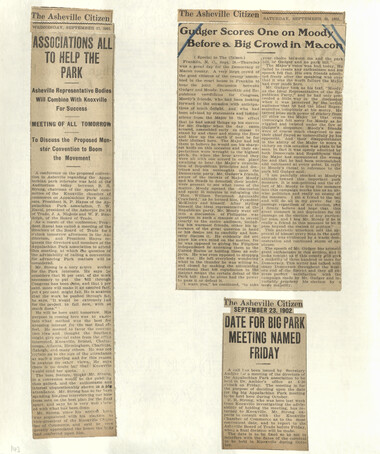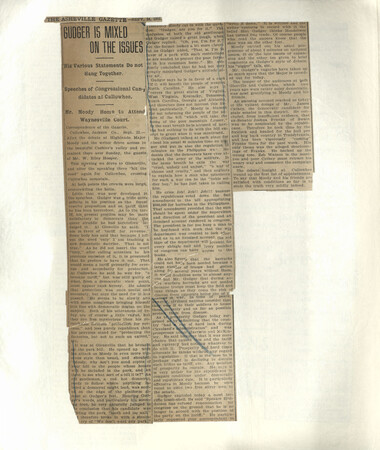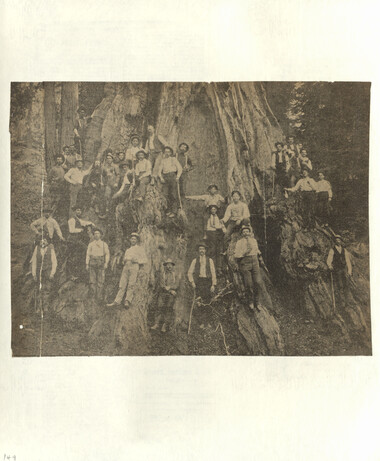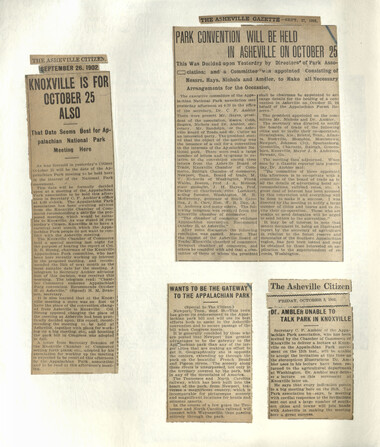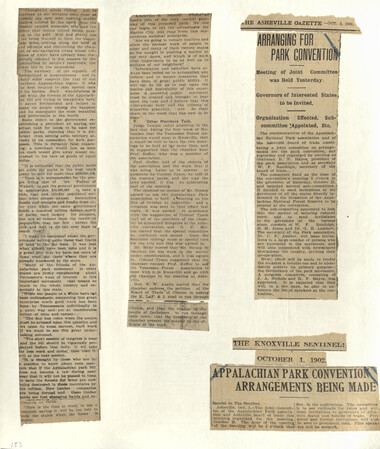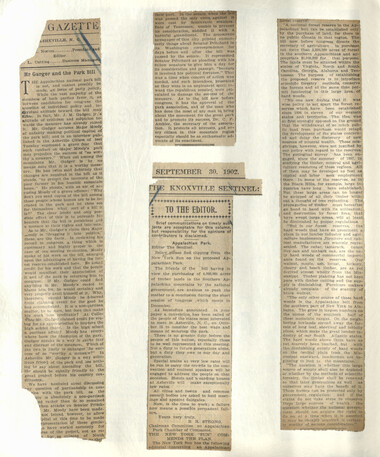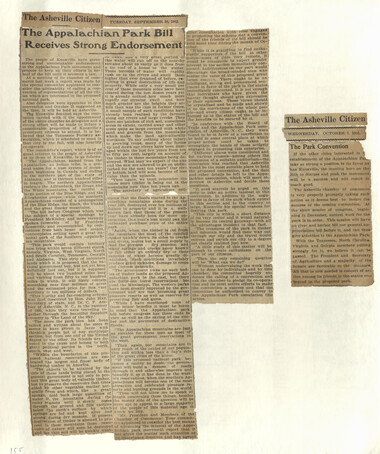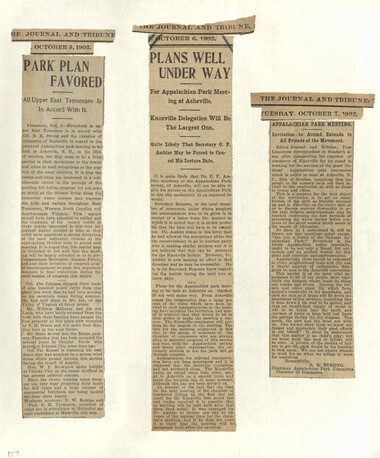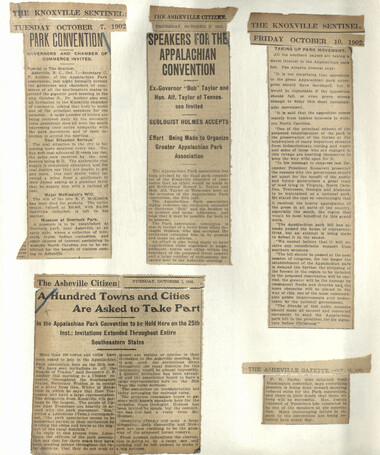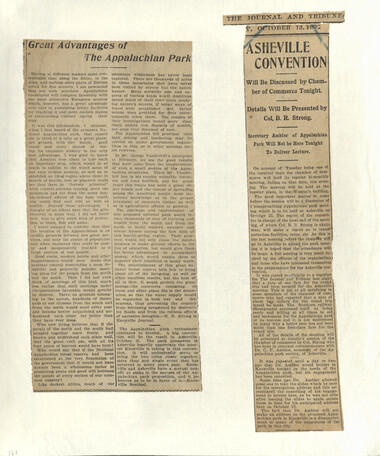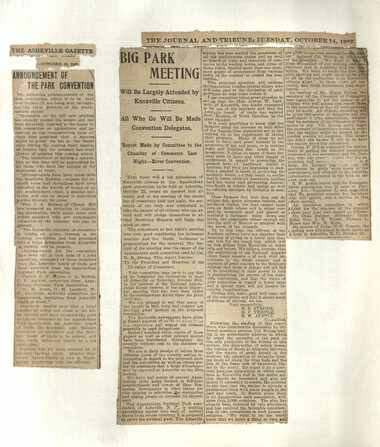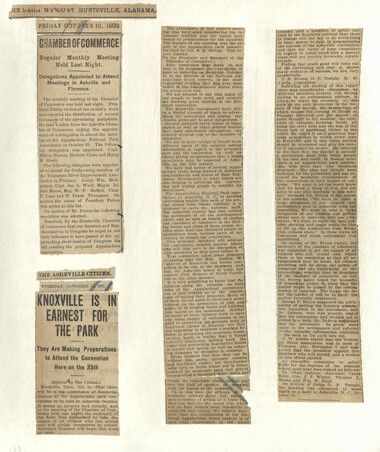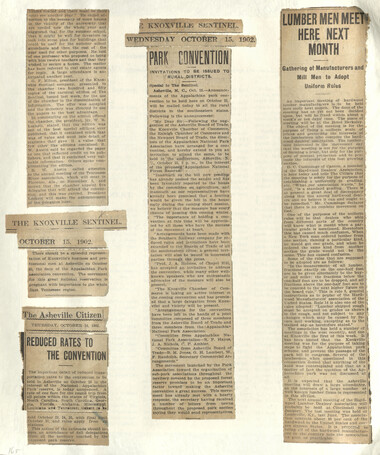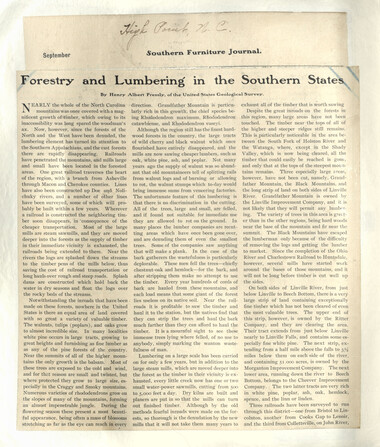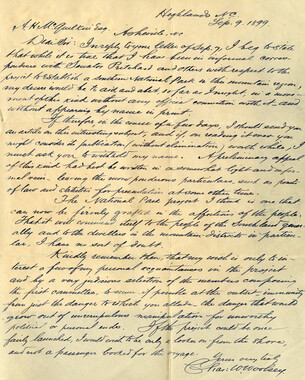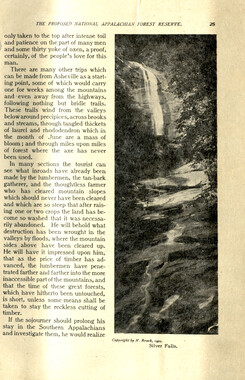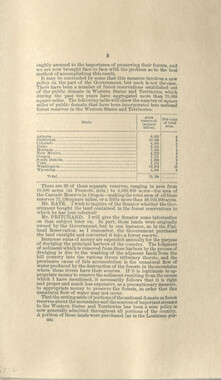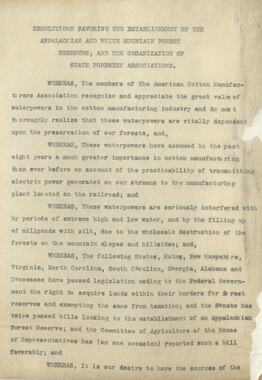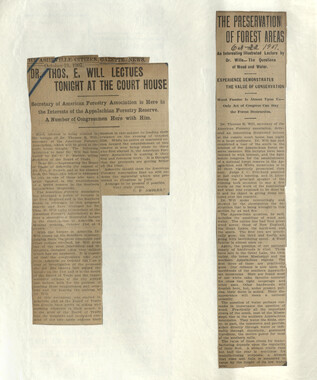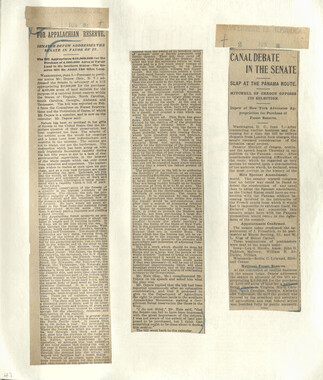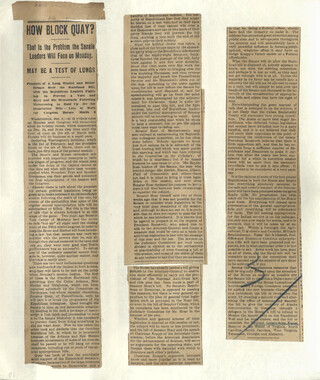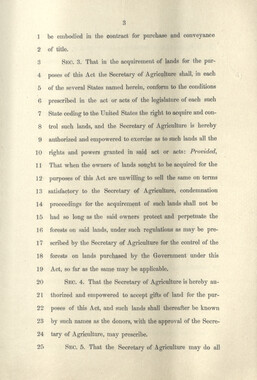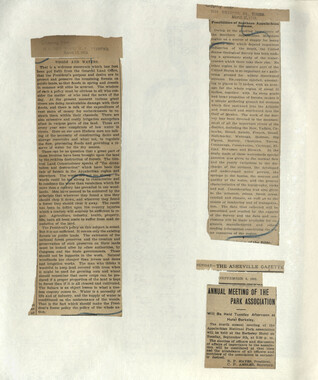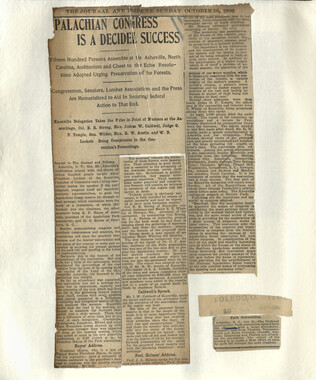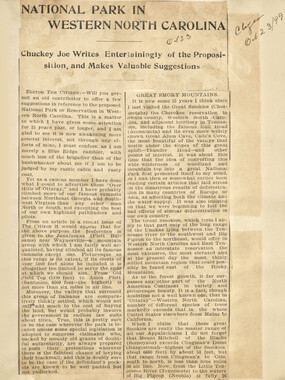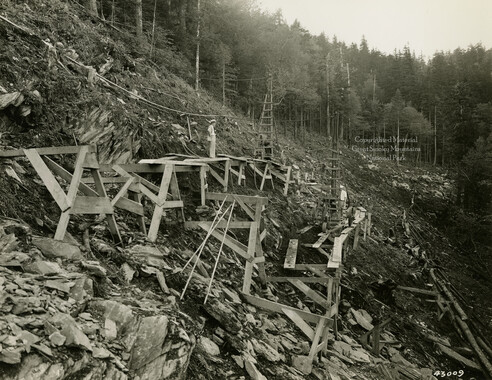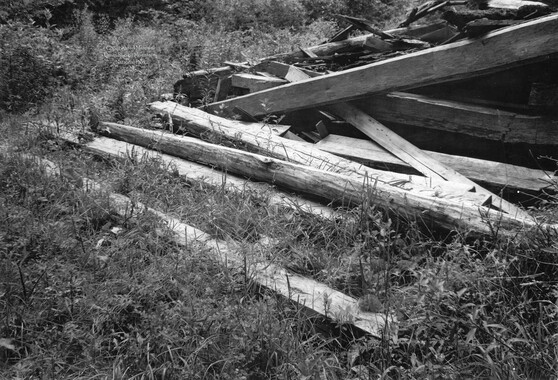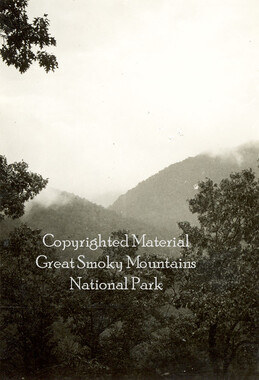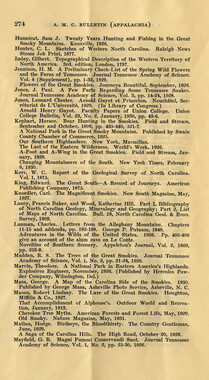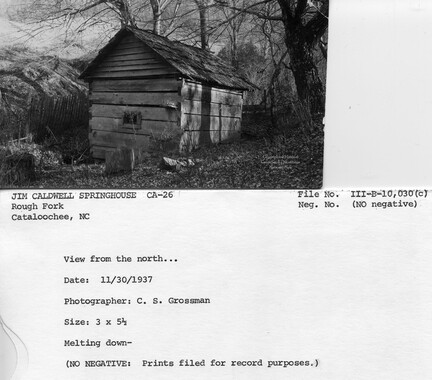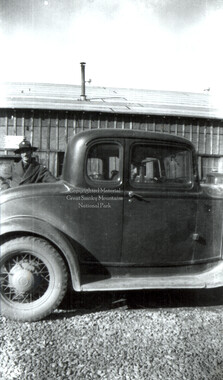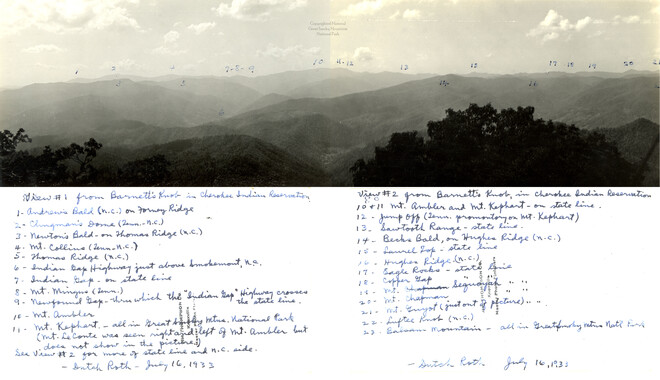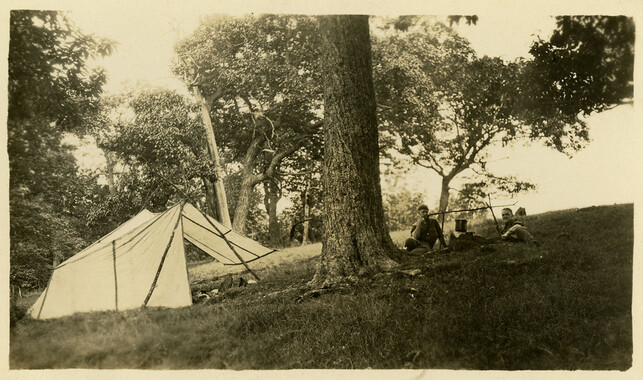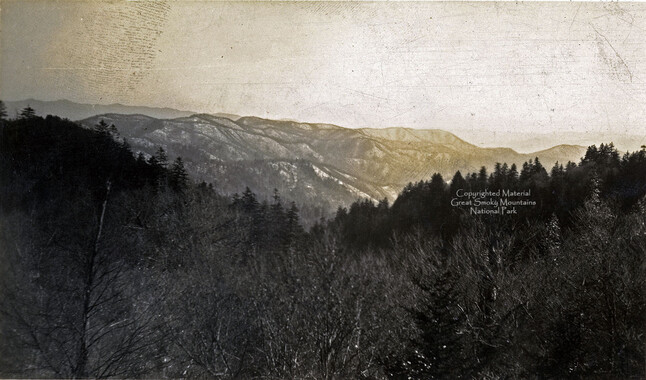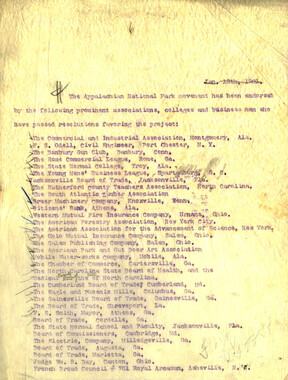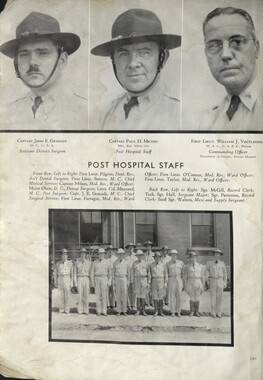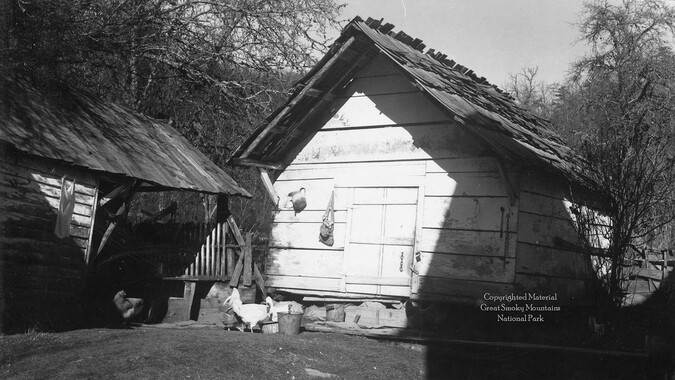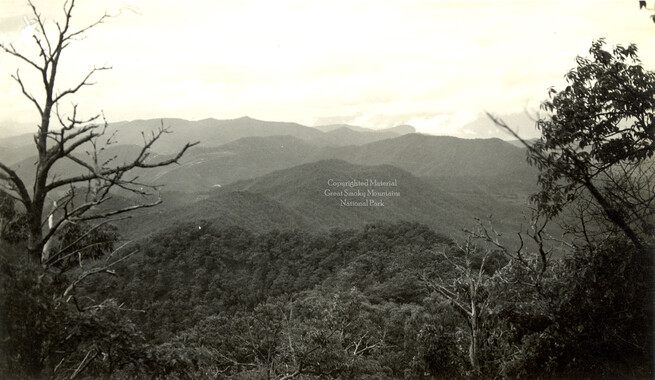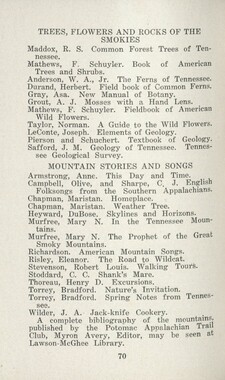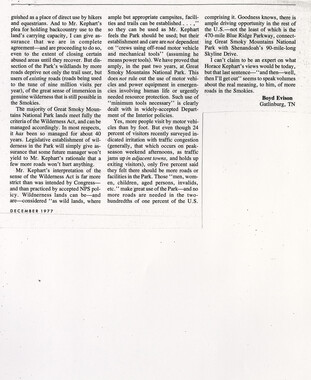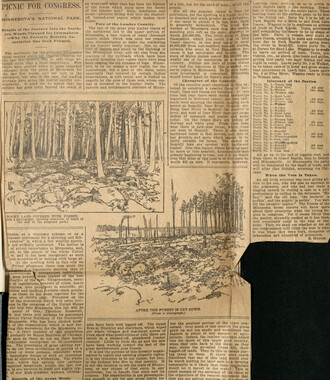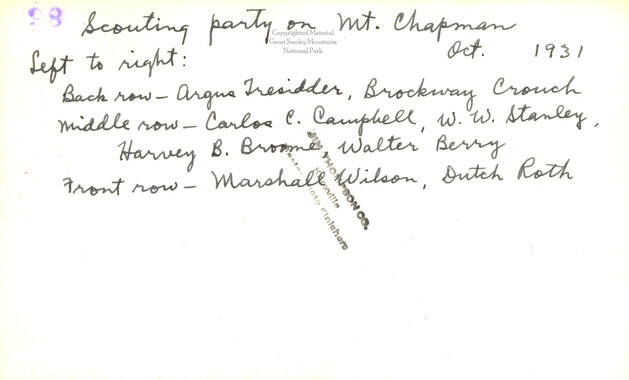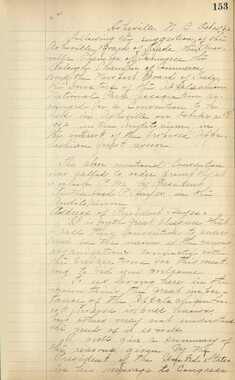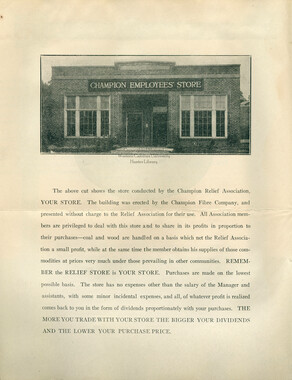Western Carolina University (21)
View all
- Canton Champion Fibre Company (2308)
- Cherokee Traditions (291)
- Civil War in Southern Appalachia (165)
- Craft Revival (1942)
- George Masa Collection (135)
- Great Smoky Mountains - A Park for America (2901)
- Highlights from Western Carolina University (422)
- Horace Kephart (941)
- Journeys Through Jackson (159)
- LGBTQIA+ Archive of Jackson County (85)
- Oral Histories of Western North Carolina (314)
- Picturing Appalachia (6798)
- Stories of Mountain Folk (413)
- Travel Western North Carolina (153)
- Western Carolina University Fine Art Museum Vitreograph Collection (129)
- Western Carolina University Herbarium (92)
- Western Carolina University: Making Memories (738)
- Western Carolina University Publications (2491)
- Western Carolina University Restricted Electronic Theses and Dissertations (146)
- Western North Carolina Regional Maps (71)
- World War II in Southern Appalachia (131)
University of North Carolina Asheville (6)
View all
- Allanstand Cottage Industries (62)
- Appalachian National Park Association (53)
- Bennett, Kelly, 1890-1974 (1463)
- Berry, Walter (76)
- Brasstown Carvers (40)
- Carver, George Washington, 1864?-1943 (26)
- Cathey, Joseph, 1803-1874 (1)
- Champion Fibre Company (233)
- Champion Paper and Fibre Company (297)
- Cherokee Indian Fair Association (16)
- Cherokee Language Program (22)
- Crowe, Amanda (40)
- Edmonston, Thomas Benton, 1842-1907 (7)
- Ensley, A. L. (Abraham Lincoln), 1865-1948 (275)
- Fromer, Irving Rhodes, 1913-1994 (70)
- George Butz (BFS 1907) (46)
- Goodrich, Frances Louisa (120)
- Grant, George Alexander, 1891-1964 (96)
- Heard, Marian Gladys (60)
- Kephart, Calvin, 1883-1969 (15)
- Kephart, Horace, 1862-1931 (313)
- Kephart, Laura, 1862-1954 (39)
- Laney, Gideon Thomas, 1889-1976 (439)
- Masa, George, 1881-1933 (61)
- McElhinney, William Julian, 1896-1953 (44)
- Niggli, Josephina, 1910-1983 (10)
- North Carolina Park Commission (105)
- Osborne, Kezia Stradley (9)
- Owens, Samuel Robert, 1918-1995 (11)
- Penland Weavers and Potters (36)
- Roberts, Vivienne (15)
- Roth, Albert, 1890-1974 (142)
- Schenck, Carl Alwin, 1868-1955 (1)
- Sherrill's Photography Studio (2565)
- Southern Highland Handicraft Guild (127)
- Southern Highlanders, Inc. (71)
- Stalcup, Jesse Bryson (46)
- Stearns, I. K. (213)
- Thompson, James Edward, 1880-1976 (226)
- United States. Indian Arts and Crafts Board (130)
- USFS (683)
- Vance, Zebulon Baird, 1830-1894 (1)
- Weaver, Zebulon, 1872-1948 (58)
- Western Carolina College (230)
- Western Carolina Teachers College (282)
- Western Carolina University (2008)
- Western Carolina University. Mountain Heritage Center (18)
- Whitman, Walt, 1819-1892 (10)
- Wilburn, Hiram Coleman, 1880-1967 (73)
- Williams, Isadora (3)
- Cain, Doreyl Ammons (0)
- Crittenden, Lorraine (0)
- Rhodes, Judy (0)
- Smith, Edward Clark (0)
- Appalachian Region, Southern (2693)
- Asheville (N.C.) (1936)
- Avery County (N.C.) (26)
- Blount County (Tenn.) (195)
- Buncombe County (N.C.) (1672)
- Cherokee County (N.C.) (283)
- Clay County (N.C.) (556)
- Graham County (N.C.) (236)
- Great Smoky Mountains National Park (N.C. and Tenn.) (519)
- Haywood County (N.C.) (3569)
- Henderson County (N.C.) (70)
- Jackson County (N.C.) (4913)
- Knox County (Tenn.) (35)
- Knoxville (Tenn.) (13)
- Lake Santeetlah (N.C.) (10)
- Macon County (N.C.) (420)
- Madison County (N.C.) (215)
- McDowell County (N.C.) (39)
- Mitchell County (N.C.) (132)
- Polk County (N.C.) (35)
- Qualla Boundary (982)
- Rutherford County (N.C.) (76)
- Swain County (N.C.) (2182)
- Transylvania County (N.C.) (270)
- Watauga County (N.C.) (12)
- Waynesville (N.C.) (86)
- Yancey County (N.C.) (72)
- Aerial Photographs (3)
- Aerial Views (60)
- Albums (books) (4)
- Articles (1)
- Artifacts (object Genre) (228)
- Bibliographies (1)
- Biography (general Genre) (2)
- Cards (information Artifacts) (38)
- Clippings (information Artifacts) (191)
- Copybooks (instructional Materials) (3)
- Crafts (art Genres) (622)
- Depictions (visual Works) (21)
- Design Drawings (1)
- Drawings (visual Works) (185)
- Envelopes (73)
- Exhibitions (events) (1)
- Facsimiles (reproductions) (1)
- Fiction (general Genre) (4)
- Financial Records (12)
- Fliers (printed Matter) (67)
- Glass Plate Negatives (381)
- Guidebooks (2)
- Internegatives (10)
- Interviews (815)
- Land Surveys (102)
- Letters (correspondence) (1013)
- Manuscripts (documents) (618)
- Maps (documents) (177)
- Memorandums (25)
- Minutes (administrative Records) (59)
- Negatives (photographs) (6090)
- Newsletters (1290)
- Newspapers (2)
- Notebooks (8)
- Occupation Currency (1)
- Paintings (visual Works) (1)
- Pen And Ink Drawings (1)
- Periodicals (193)
- Personal Narratives (10)
- Photographs (12976)
- Plans (maps) (1)
- Poetry (5)
- Portraits (4568)
- Postcards (329)
- Programs (documents) (181)
- Publications (documents) (2443)
- Questionnaires (65)
- Relief Prints (26)
- Sayings (literary Genre) (1)
- Scrapbooks (282)
- Sheet Music (2)
- Slides (photographs) (402)
- Songs (musical Compositions) (2)
- Sound Recordings (796)
- Specimens (92)
- Speeches (documents) (18)
- Tintypes (photographs) (8)
- Transcripts (322)
- Video Recordings (physical Artifacts) (23)
- Text Messages (0)
- A.L. Ensley Collection (275)
- Appalachian Industrial School Records (7)
- Appalachian National Park Association Records (336)
- Axley-Meroney Collection (2)
- Bayard Wootten Photograph Collection (20)
- Bethel Rural Community Organization Collection (7)
- Blumer Collection (5)
- C.W. Slagle Collection (20)
- Canton Area Historical Museum (2110)
- Carlos C. Campbell Collection (462)
- Cataloochee History Project (64)
- Cherokee Studies Collection (4)
- Daisy Dame Photograph Album (5)
- Daniel Boone VI Collection (1)
- Doris Ulmann Photograph Collection (112)
- Elizabeth H. Lasley Collection (1)
- Elizabeth Woolworth Szold Fleharty Collection (4)
- Frank Fry Collection (95)
- George Masa Collection (173)
- Gideon Laney Collection (452)
- Hazel Scarborough Collection (2)
- Hiram C. Wilburn Papers (28)
- Historic Photographs Collection (236)
- Horace Kephart Collection (861)
- Humbard Collection (33)
- Hunter and Weaver Families Collection (1)
- I. D. Blumenthal Collection (4)
- Isadora Williams Collection (4)
- Jesse Bryson Stalcup Collection (47)
- Jim Thompson Collection (224)
- John B. Battle Collection (7)
- John C. Campbell Folk School Records (80)
- John Parris Collection (6)
- Judaculla Rock project (2)
- Kelly Bennett Collection (1482)
- Love Family Papers (11)
- Major Wiley Parris Civil War Letters (3)
- Map Collection (12)
- McFee-Misemer Civil War Letters (34)
- Mountain Heritage Center Collection (4)
- Norburn - Robertson - Thomson Families Collection (44)
- Pauline Hood Collection (7)
- Pre-Guild Collection (2)
- Qualla Arts and Crafts Mutual Collection (12)
- R.A. Romanes Collection (681)
- Rosser H. Taylor Collection (1)
- Samuel Robert Owens Collection (94)
- Sara Madison Collection (144)
- Sherrill Studio Photo Collection (2558)
- Smoky Mountains Hiking Club Collection (616)
- Stories of Mountain Folk - Radio Programs (374)
- The Reporter, Western Carolina University (510)
- Venoy and Elizabeth Reed Collection (16)
- WCU Gender and Sexuality Oral History Project (32)
- WCU Mountain Heritage Center Oral Histories (25)
- WCU Oral History Collection - Mountain People, Mountain Lives (71)
- WCU Students Newspapers Collection (1923)
- Western North Carolina Tomorrow Black Oral History Project (69)
- William Williams Stringfield Collection (2)
- Zebulon Weaver Collection (109)
- African Americans (390)
- Appalachian Trail (35)
- Artisans (521)
- Cherokee art (84)
- Cherokee artists -- North Carolina (10)
- Cherokee language (21)
- Cherokee pottery (101)
- Cherokee women (208)
- Church buildings (190)
- Civilian Conservation Corps (U.S.) (111)
- College student newspapers and periodicals (2012)
- Dams (107)
- Dance (1023)
- Education (222)
- Floods (61)
- Folk music (1015)
- Forced removal, 1813-1903 (2)
- Forest conservation (220)
- Forests and forestry (1195)
- Gender nonconformity (4)
- Great Smoky Mountains National Park (N.C. and Tenn.) (181)
- Hunting (45)
- Landscape photography (25)
- Logging (119)
- Maps (83)
- Mines and mineral resources (8)
- North Carolina -- Maps (18)
- Paper industry (38)
- Postcards (255)
- Pottery (135)
- Railroad trains (72)
- Rural electrification -- North Carolina, Western (3)
- School integration -- Southern States (2)
- Segregation -- North Carolina, Western (5)
- Slavery (5)
- Sports (452)
- Storytelling (243)
- Waterfalls -- Great Smoky Mountains (N.C. and Tenn.) (66)
- Weaving -- Appalachian Region, Southern (280)
- Wood-carving -- Appalachian Region, Southern (328)
- World War, 1939-1945 (173)
Appalachian National Park Association Newspaper Clippings, 1899-1902
Item
Item’s are ‘child’ level descriptions to ‘parent’ objects, (e.g. one page of a whole book).
-
-
Southern Appalachian forest Resern In the Fifty-sixth Congress, n little over a year ago. a bill was introduced Which provided "for the purchase of a national forest reserve in the southern Appalachian mountains." It was referred to the proper committee, which reported it favorably, but no action was taken by Congress. The bill di'd of course, on March 4. 1901, when the official life of that Congress expired. The samp bill lias been introduced in the present Congress—-the Fifty-seventh—by Senator Pritehard. and there is a lively hope that it may become a law before the expiration of the term of the present body, on March 4. 1903. This bill empowers the Secretary of her, with hard-wood trees; and ifie timber, on arriving at maturity, is K be sold standing, to be cut under govo,omental inspection. This is to be sold it public auction, after appraisement, ad in no case for less than the appraised value, and the money so received is o go into the treasury of the United Strtes. It is expected the reserve will, in a few years, thus become self-supporting, and even more. Though the Pritehard bill names six slates within whose area lands may be purchased for a forest reserve, it does not follow that land will he purchased in all of them. In thp Agricultural Department appropriation bill for 1001 was an item covering the expense of a thorough forestry examination of this whole region. This was made, and it urges that this is the best region in the East possible for the purpose, shall be created a fores (reserve. The wholesale destruction of our woodlands, without reforestation, is a reproach and a shame to our people. Trees are cut down on areas which are unfit for profitable agriculture; forest fires destroy the young growth. A farmer plants corn in the spring and harvests it in the fall. He sows wheat in the fall, which iic harvests the next summer.' Ho plants and cares for fruit trees, whose profits he cannot hope to enjoy for several years. Why has the average farmer never realized that timber is a crop quite as much as is corn, or wheat, or fruit—the only difference being that he has to wait longer for the profit from his investment'.' Take a hilly country, covered with trees. If this all be cleared off, for the areas, each lying partly in Tennessee anil parly in North Carolina, connected by a u.ii-row strip extending along the bonndaiy between the two stales, and embracing land in each of them. The membra) eiuls with tin's statement: Your petitioner therefore states that, in its opinion, by far the best land lor the Appalachian national park lies between paraU^i«ff'»«d>aai«fli.«iw»Mr1iatiUide, and between the lines S3 and S6 of west longitude, and within the tract described as follows: Beginning at Joanna Hal I mountain, in the state of North Carolina, on the lino dividing! the county of Craham from CheroKee and Ma-on counties, and running thence easterly along said line and the line between eastern Wraham county and Swain county to a pilnt on the Tuck- aselgee river near Bushnell; thence up the Tuckaseigee river to a point miles west of Bryson City; thence due north four mil ist about twelve miles to the 'me dividing P and Jackson counties: thence south t. Tuckaseigee river; trence east to the Plott Balsam ridge: 'hen along said ridjre, crossing the line b'tween Ilavv Jackson counties t-> a point two miles SOUTHERN APPALACHIAN FOREST RESERVE As Proposed to Congress by the Association. Agriculture to purchase land, suited to ,'he purposes of a national forest reserve. in the Appalachian mountains, "within the state of Virginia, North Carolina, South Carolin, Georgia, Alabama and Tennessee." The total area authorized to be purchased is not to exceed two million acres, and the sum appropriated is not to exceed $0,000,000. "or as much thereof as may be required." That is to say, the price is not to exceed $2.50 per acre- and to be as much less as it is possible whereby to acquire title to the land. This is to be known as the "Southern Appalachian Forest. Reserve," and is to be under the direct: supervision of the Department of Agriculture. It is not intended that the entire sum shall be expended hastily, or at. once: for the appropriation is made available until .lime 30. 1012- -thus giving ten years for the selection and purchase of lands fitted for the purposes specified. The bill has already been favorably ret.o.-i,„j present Congress, and it will be strongly urged for passage. Thousands of petitions have been already received asking prompt and favorable action. There is a. confusion of terms regarding this proposed governmental area which should he cleared up. It is often spoken of as a "national park." This term is wrong. In the Yellowstone National Park, the phrase is properly used, because that area is designed primarily for the pleasure of the people of the na- ion. It is also used dfreetly in the itle of the Chlckamauga—Chattanooga Vational Park, as these areas are ireserved primarily because of the his- orical interest of the battle-fields. But 'his is not intended for pleasure, nor are there national historical associations of iny importance connected therewith. It is intended to be a forest reserve, not a. national park. In other words, it is to be reforested, where denuded of tim- included an estimate of the amount and condition of the standing timber, the character and distribution of the various species of timber trees, the density and value of the forest growth, the size and nature of the present holdings, prices at. which the forest lands are now held, and the general conditions of the region for the prosecution of forestry on a large scale. Besides these lines of inquiry, a thorough study of the region was made concerning its topographical features; the relations of the soils, forest cover, and rainfall: of the flow of the various streams which have their origin in this region, during different seasons of the year, and the influence upon this water flow of the clearing of the timber. Secretary of Agriculture Wilson made a report to Congress, based upon this survey and examination, in which he earnestly approved of the project. In if he says that this region is better adapted to forestry than to agricultural purposes. If contains a greater variety of hardwood trees than any other region of the United States, since here the Northern nnd Southern species meet. It contains within its area no large settlements nor mining interests that would interfere with the management of a forest reserve. It contains the largest mountain masses, and the wildest and most picturesque scenery east of the Rocky mountains. The rapid consumption of our timber supplies, the extensive destruction of forests by fire, and the resulting increase in the irregularity of the 8ow of water in the streams, have caused a general public interest in forest problems. In response to the demand for the conservation of regions suitable only for forest uses, the government has already set aside in various forest reserves an area of more than 70,000 square miles in the West. There is not a single forest reserve in the East. Hence the secretary sake of the timber, the ground is not Worth cultivating. As soon as the forest co.ering is removed, and more especially if the cultivation of the land is undertaken, the soil which is of any value to plant life is washed away by rains, filling up the beds of the streams below and leaving nothing but steril ! slopes If only the trees fit for timber were cut, and that without, injuring th« yiiunjer growth, anil new trees were planted to take the places of those removed, this land could be made steadily profitable. At some points in the ea-jt, lards from which the pine has all iten C'ir.off have been planted with pine si edr, anr, it is estimated these reforested areas will pay 0 per cent per year on their value. Should this bill become a law—and the writer most earnestly hopes that it will —the areas to be purchased will depend upon the judgment of the head of the forestry bureau of the department of agi'icnlture. Nor will any exorbitant price be paid. People owning these mountain lands, who are deluding themselves with roseate dreams of realizing a small fortune off the government, may I as well abandon nil such foolish ideas. Nor will this area bo all in one broad tract. Valley lands, suitable for farm ing. will not he taken. Accompanying this article is a map, reproduced in the report of the secretary of agriculture on this bill, but he does not recommend the purchase of all the land within the boundaries there laid down. The map was prepared by an association of private citizens, interested in forestry, called the "Appalachian National Park Association." That body sent, a memorial to congress, accompanied by the map given with this article, which shows the region, in the opinion of the gentlemen of the association, best fitted for forestry operations. As will be seen, it embraces lands in Western North Carolina and Eastern Tennessee. It comprises in reality two west of Waynesville; thence northeastwardly tn Pigeon river; thence down Pigeon river to Fines creek; thence in a northwestwardly direction to French Broad river at the mouth of Big l.aurcl creek: thence due east to the line dividing- Madison and Yancey counties: thence due south to a point two miles north of the Swannanoa river; thence easterly along a Hue parallel with and two miles north of the line of the Southern Railway company to a -eoint due north of old Fort: thence, due north to North Toe river; thence down the North Toe river to the line dividing the State Of Tennessee from the slate of North Carolina ; thence westerly in the /date of Tennessee to Bis Butt; at the corner of Washington, Green and Unicoi com In Tennessee, and of Madison county, in North Carolina: thence southwest' along the line dividing the state of Tennessee from ;be state of North Carolina to Rocky Ridge: thence southwesterly in a ttraight line to the French Broad River at the mouth nf Paint Creel-;: thence down the French Broad River to the Mouth of Ro-k Creek; thmee westwardly to the eouheast corner of Jeffi Tern., thence scuthwestwanlly to Roc ml Top, at a corner in the-easterly line of Blmnt county, Tiiiii.; thence in a south- wistwardlv direction to the Tonm lire at the mouth of Abram or Panther Creek: thence south i" tie- line dividing Cherokee and Graham counties, in North Carolina, and thence along said dividing lin? eastwardly to Joanna Bald Mountain. h» place of beginning. (See Map.) Should the bill become a law. it v within the power of the department of agriculture to select and purchase lands within any or all of the six states named n the beginning of ibis article, instead if merely in North Carolina and nejgee. Nor is it at all necessary that, the lands purchased should adjoin and form one continuous Iruot. It is fi ble to buy tracts separated by miles ot distance. The hill authorizes I lie piw* chase of 2.000.000 neves, which is ".125 sqinre miles. This would make a half- down very respectable-sized rcsei on" for each state—if it were deemed best to do this. S. S. KNARENSHlE.
Object
Object’s are ‘parent’ level descriptions to ‘children’ items, (e.g. a book with pages).
-
This is one of two notebooks assembled by the Appalachian National Park Association that includes documents and news clipping about the organization. The Appalachian National Park Association was formed in 1899 for the purpose of promoting the idea of a national park in the eastern U.S. Although housed in Asheville, North Carolina, the organization was a multi-state effort, attracting representatives from seven southern states. One of the highlights of the group’s activities was a convention held in 1902 to which 1,500 people attended. The association lobbied Congress for the creation of a park, but with limited success. The association disbanded in 1905.
-

